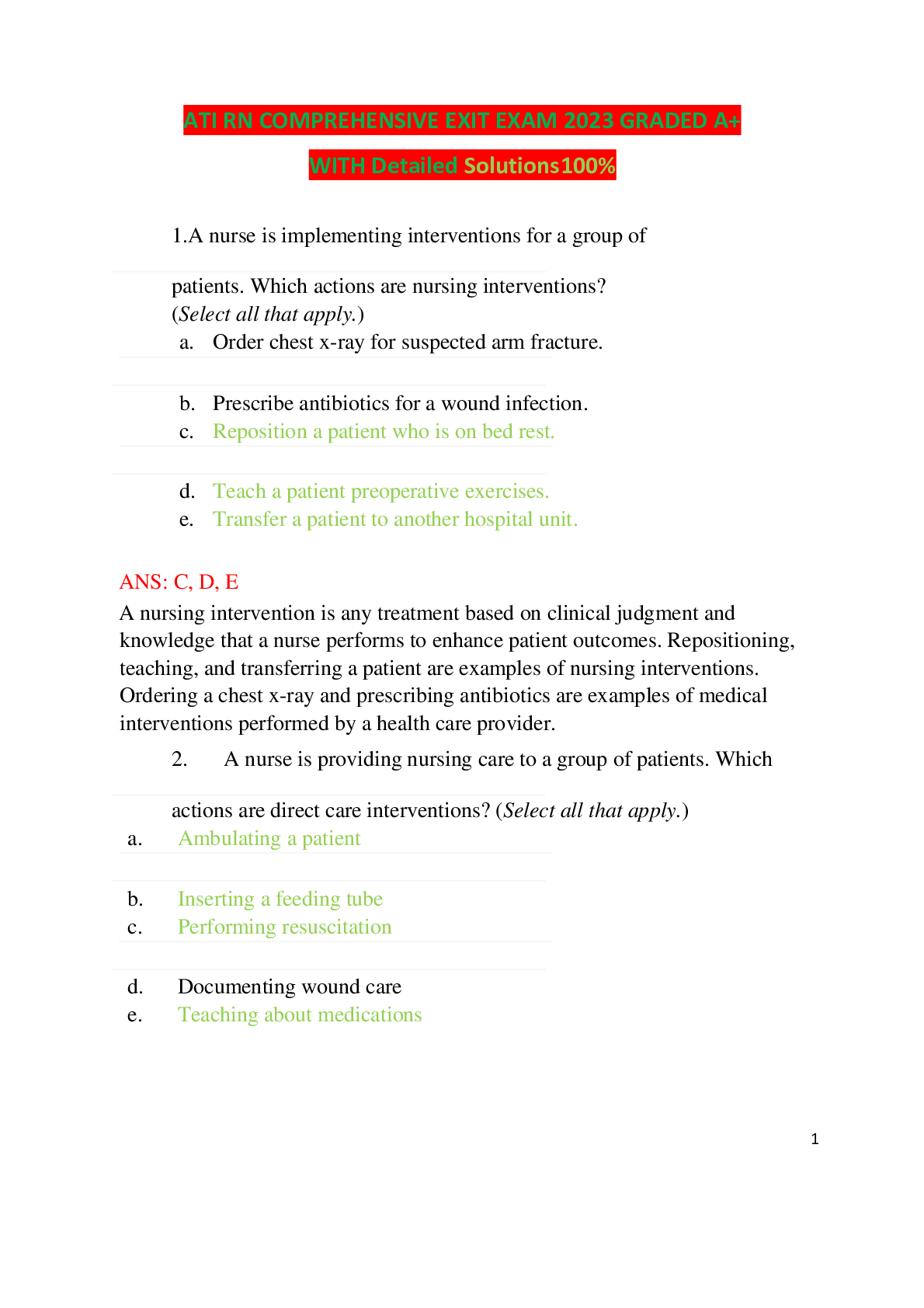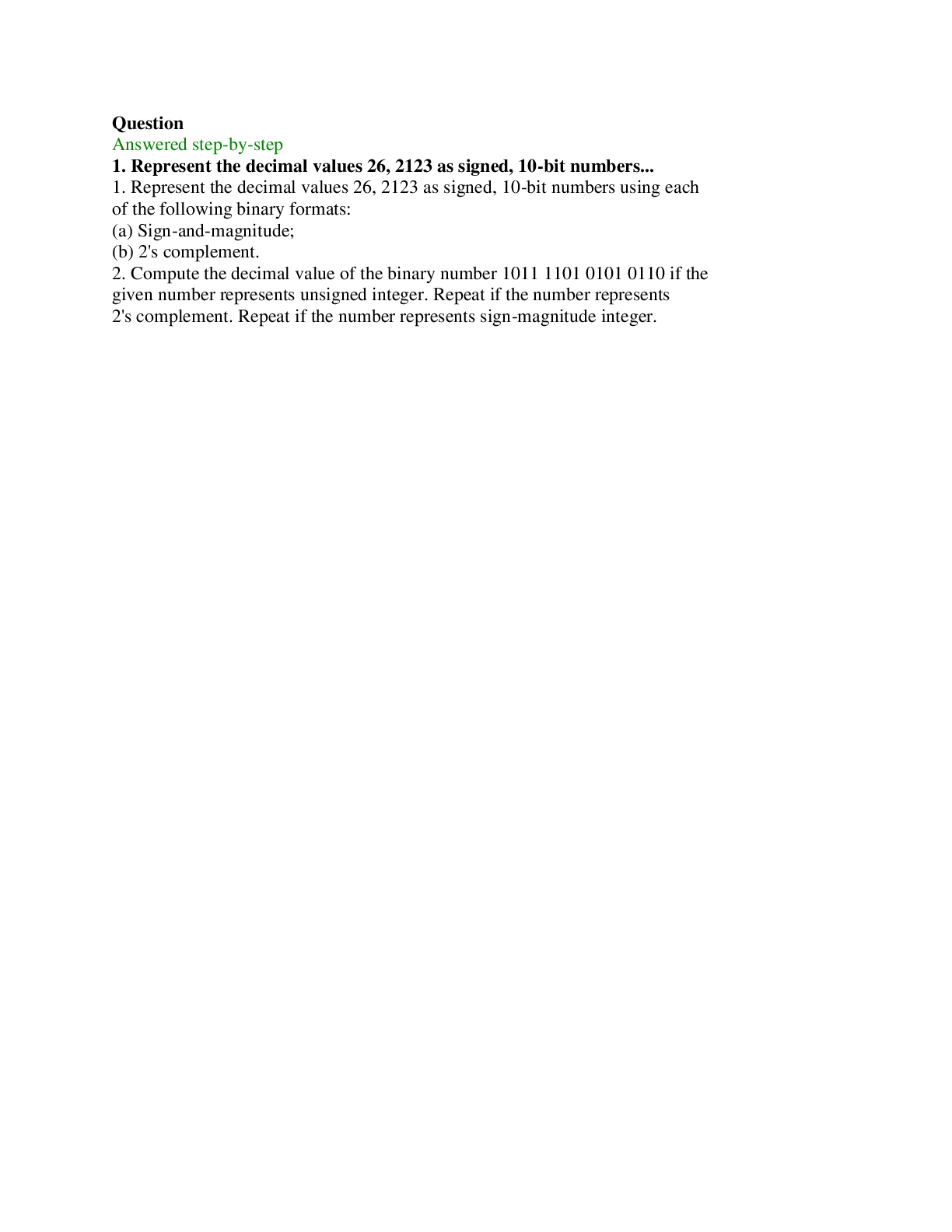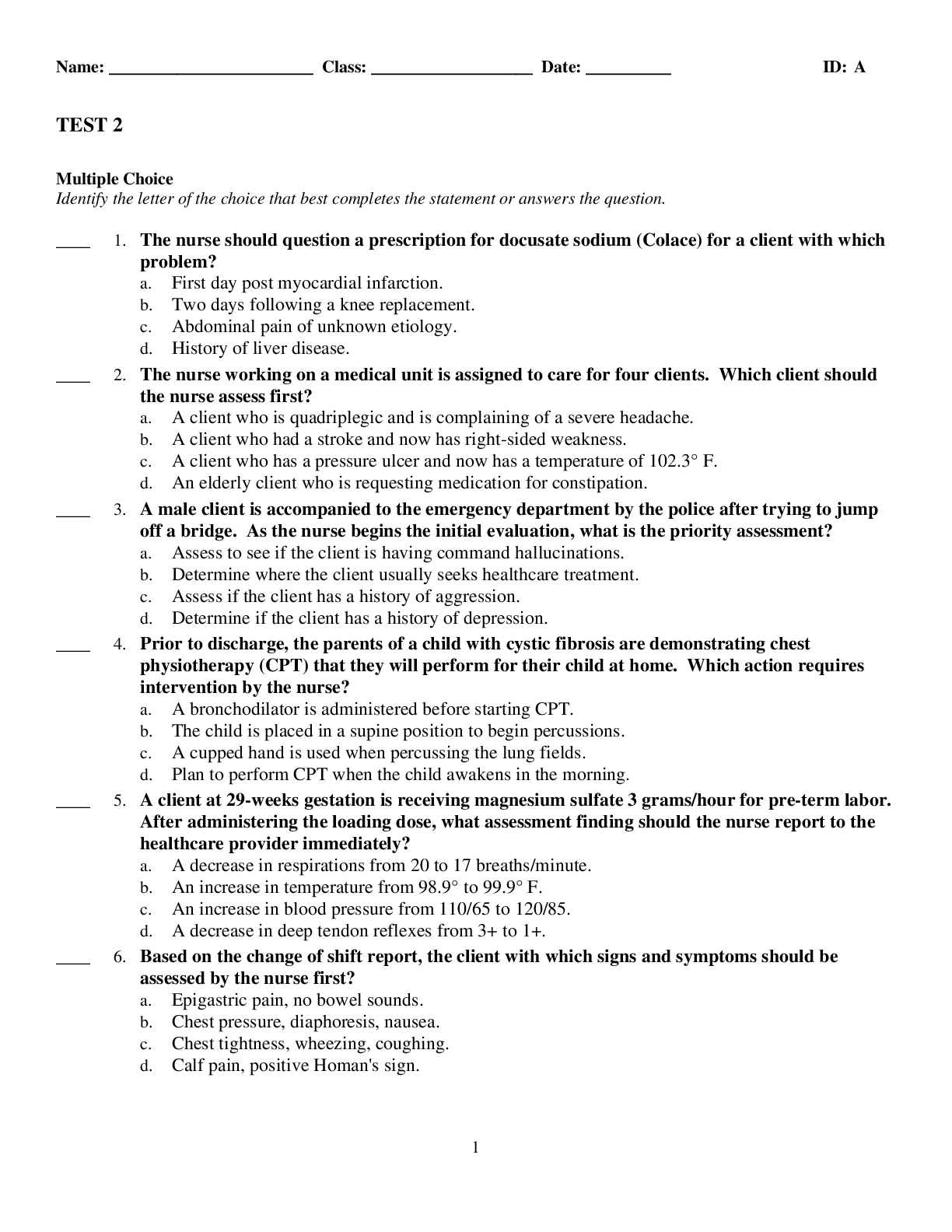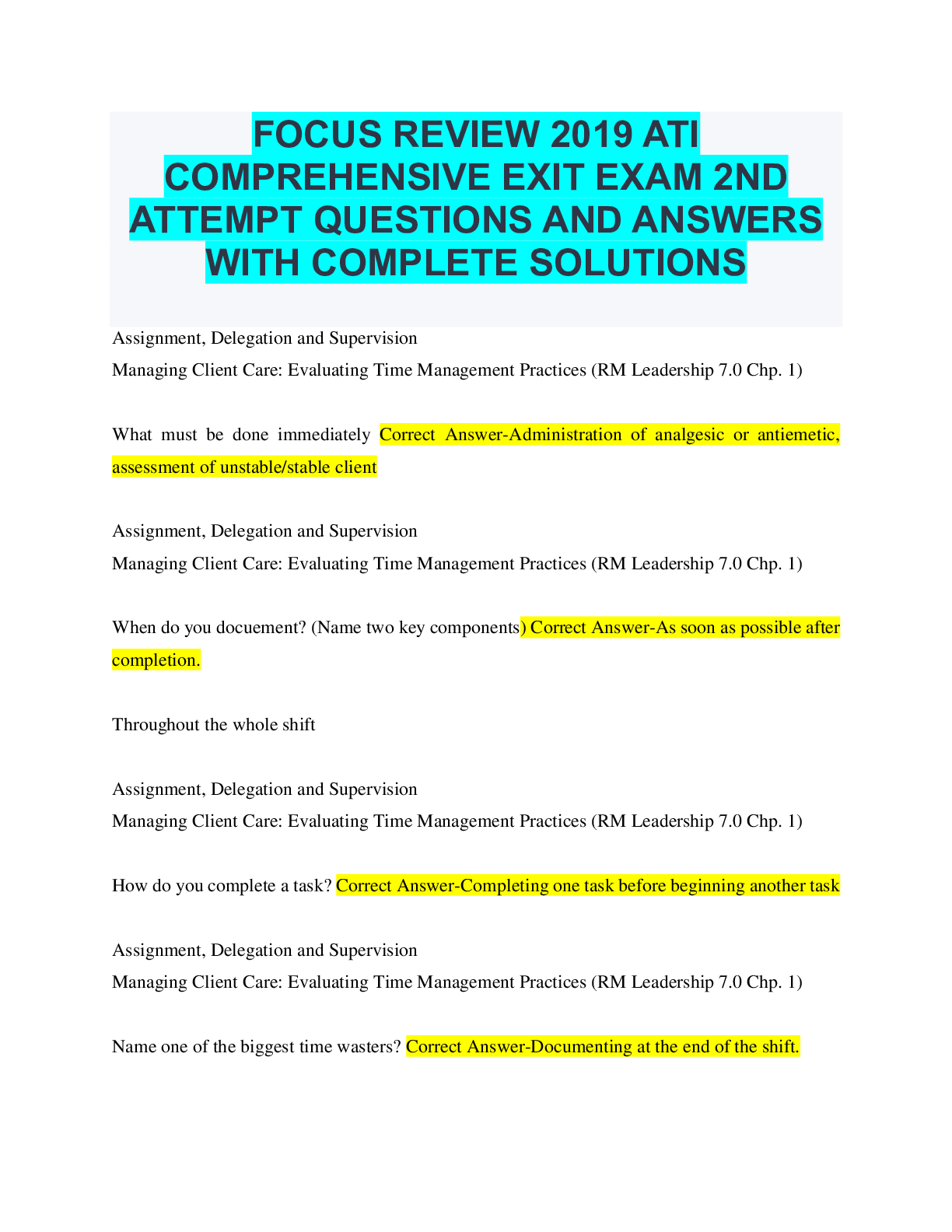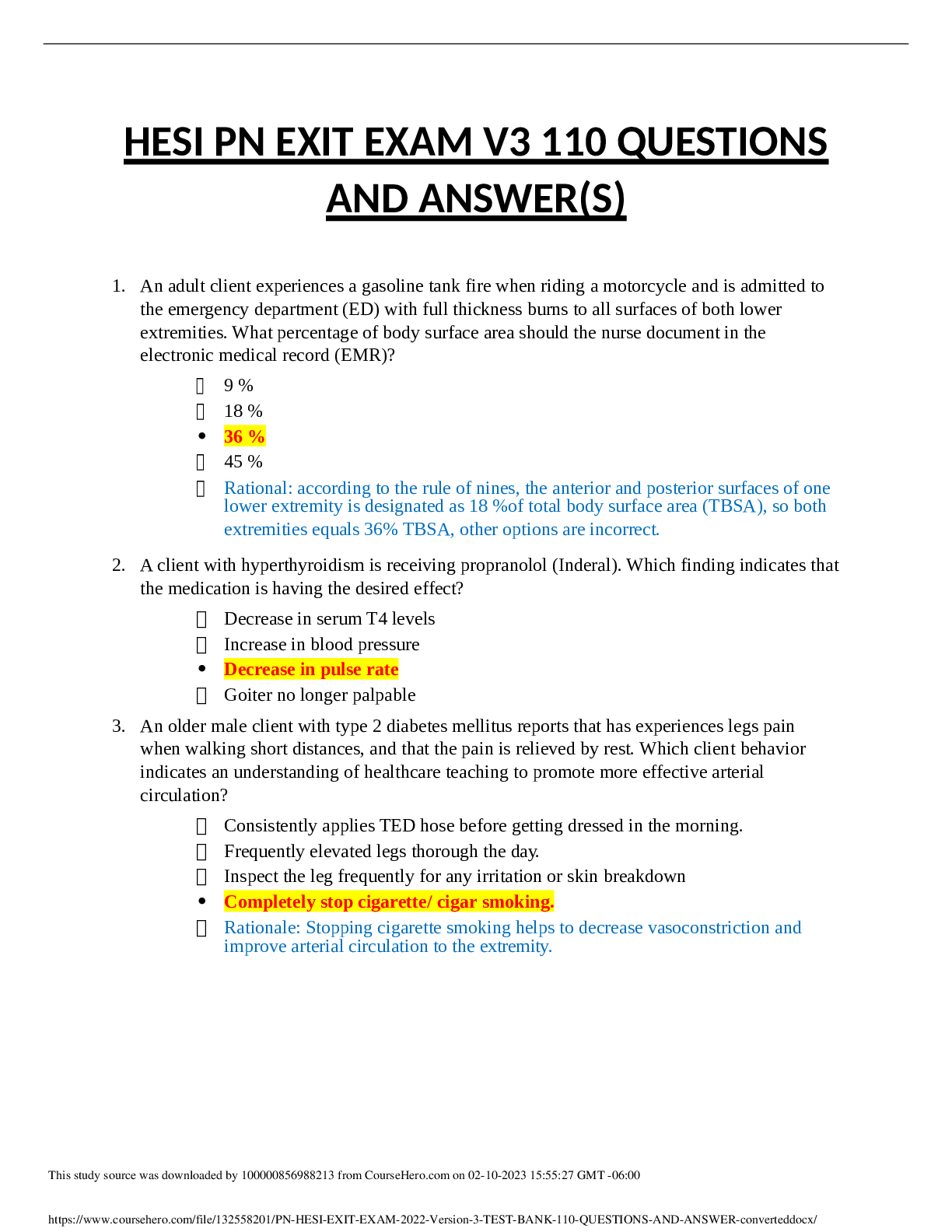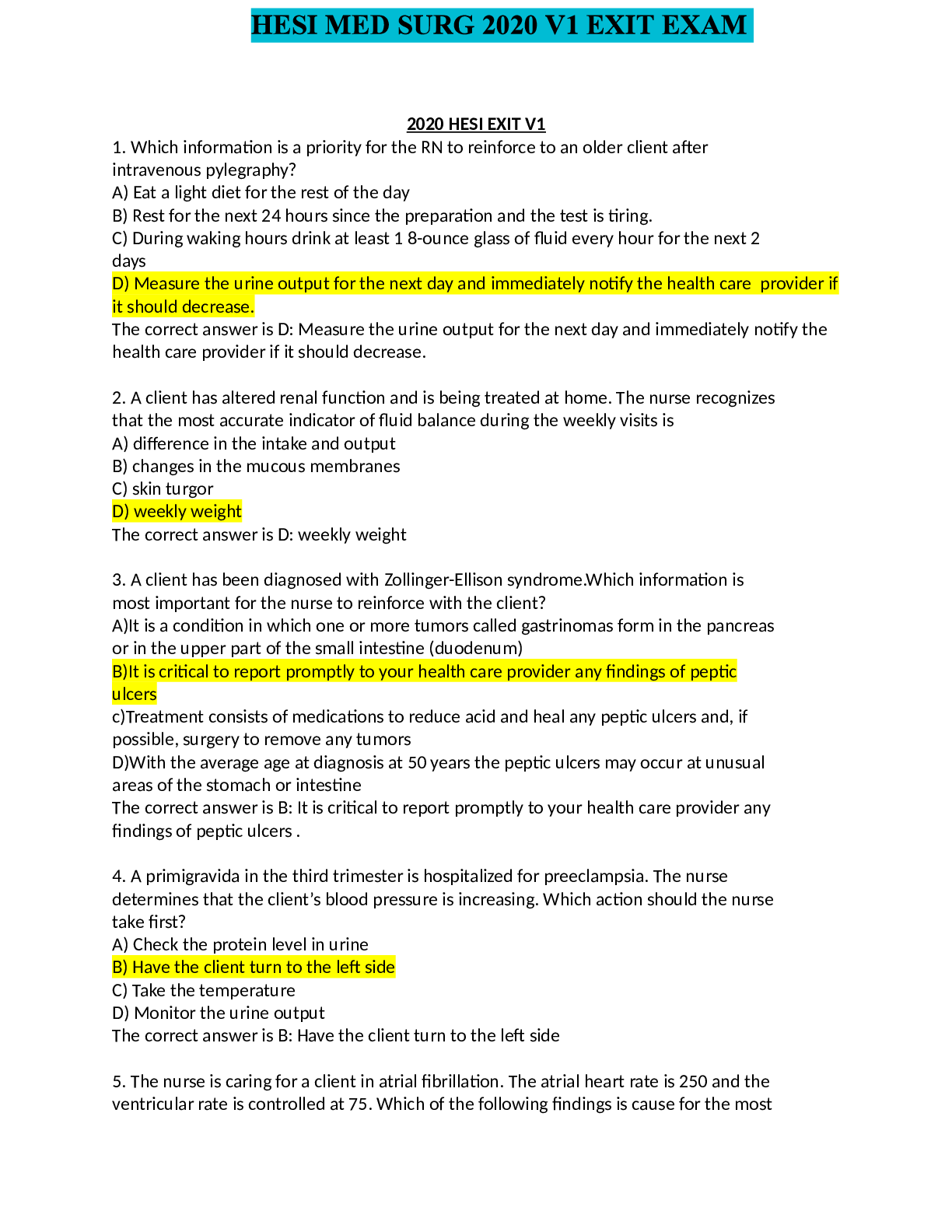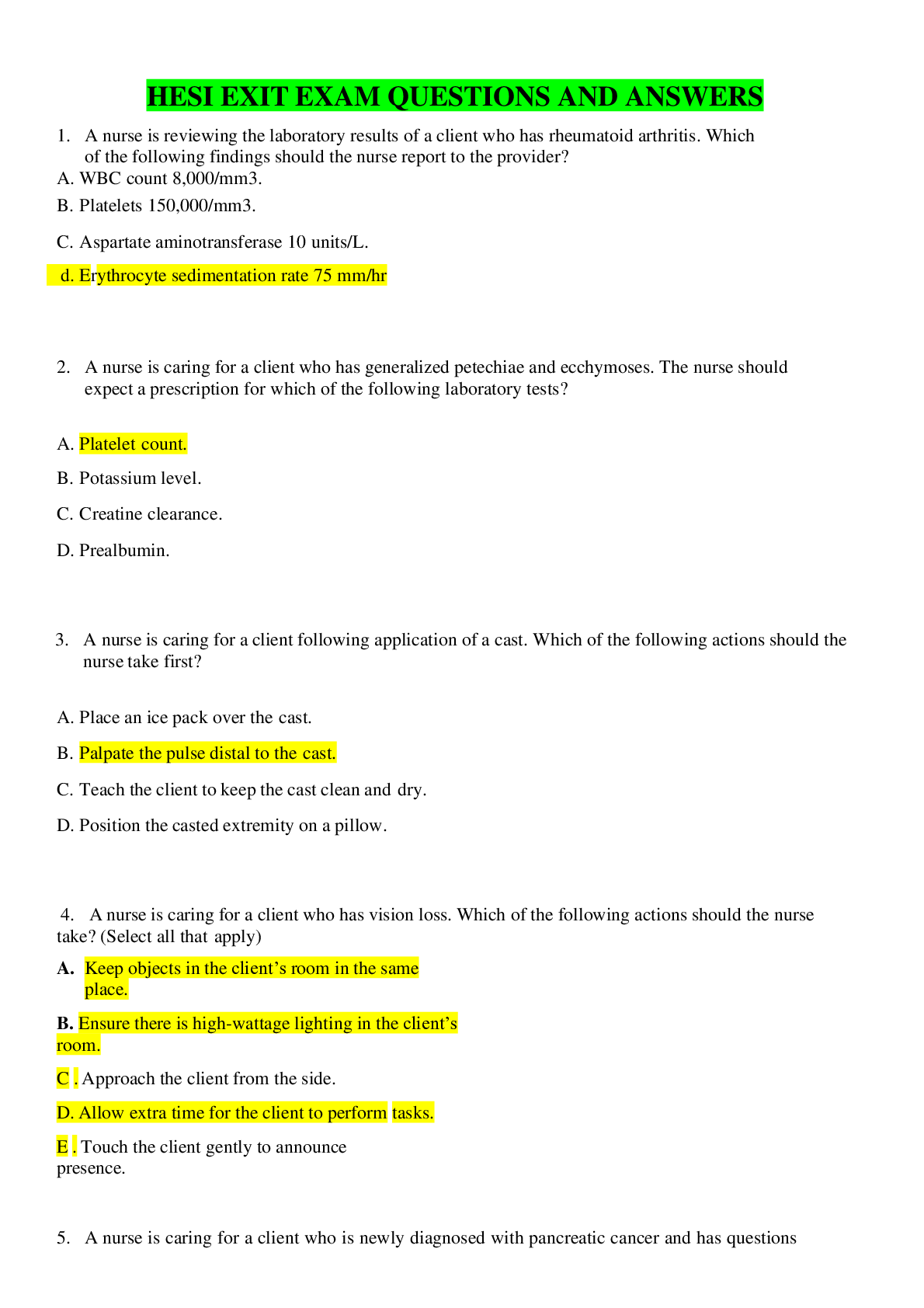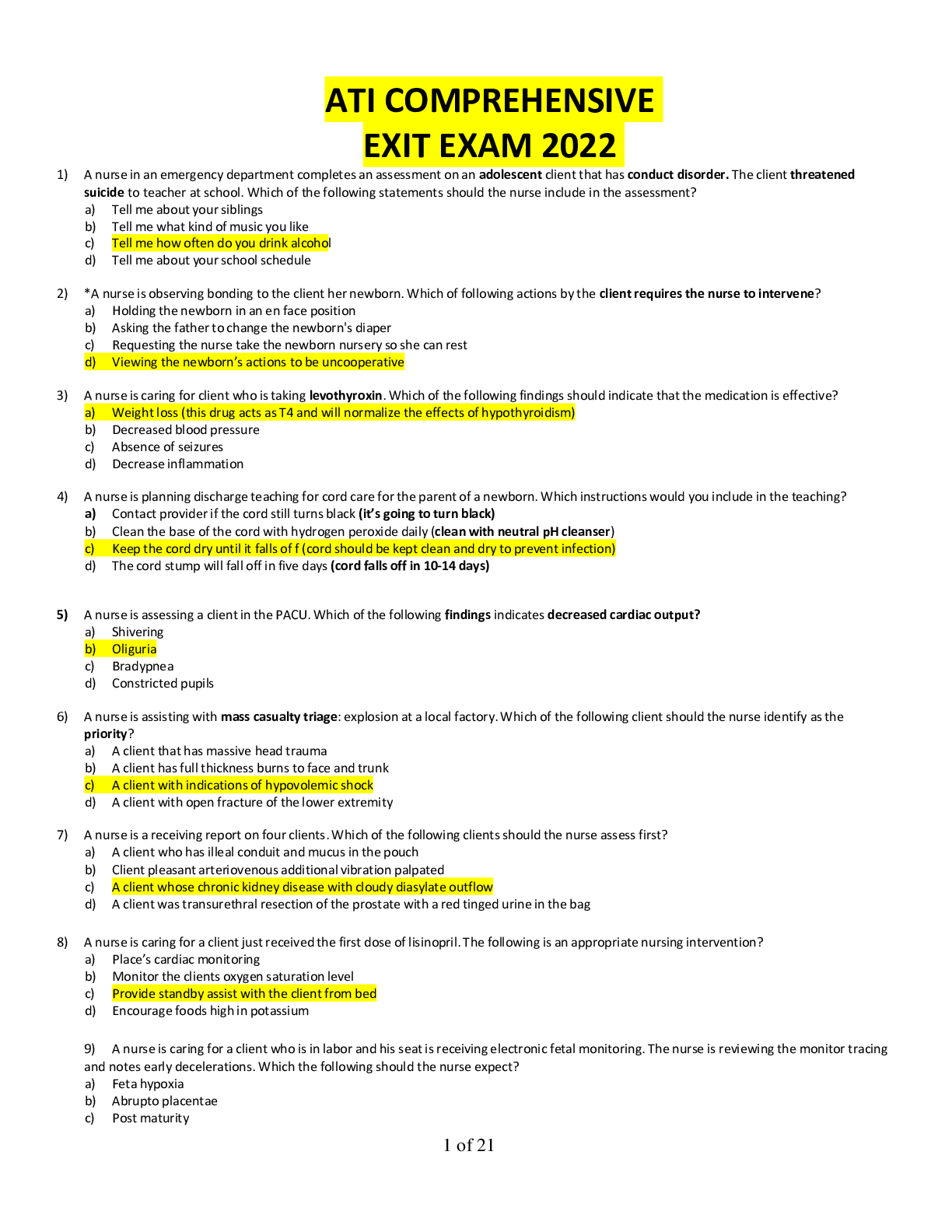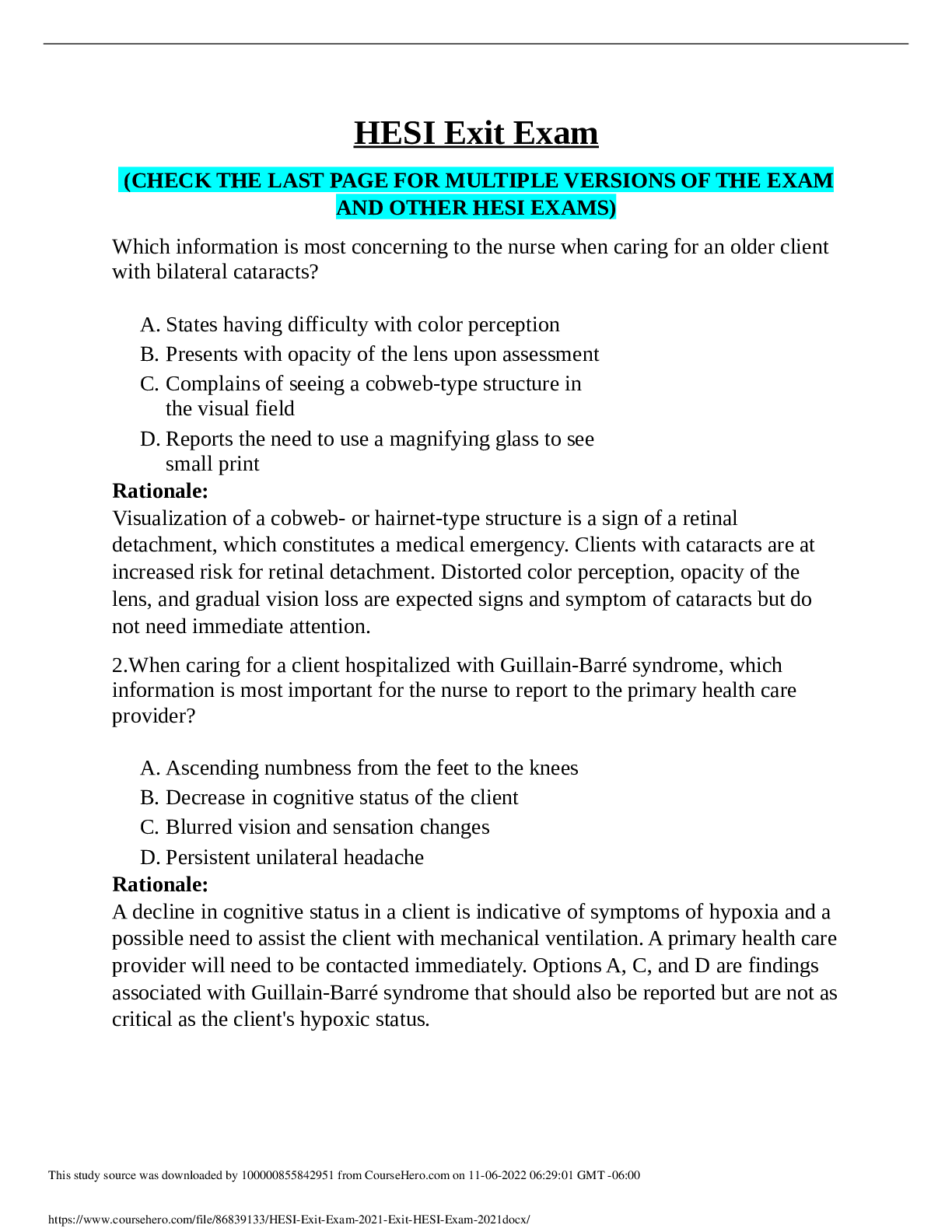*NURSING > QUESTIONS & ANSWERS > PN HESI Exit Exam 2 |Latest Complete Guide (questions & answers) A+ guide. BEST FOR 2021/2022 (All)
PN HESI Exit Exam 2 |Latest Complete Guide (questions & answers) A+ guide. BEST FOR 2021/2022
Document Content and Description Below
PN HESI Exit Exam 2 TEST 2 Multiple Choice Identify the letter of the choice that best completes the statement or answers the question. 1. The nurse should question a prescription for docusate sodium ... (Colace) for a client with which problem? a. First day post myocardial infarction. b. Two days following a knee replacement. c. Abdominal pain of unknown etiology. d. History of liver disease. 2. The nurse working on a medical unit is assigned to care for four clients. Which client should the nurse assess first? a. A client who is quadriplegic and is complaining of a severe headache. b. A client who had a stroke and now has right-sided weakness. c. A client who has a pressure ulcer and now has a temperature of 102.3° F. d. An elderly client who is requesting medication for constipation. 3. A male client is accompanied to the emergency department by the police after trying to jump off a bridge. As the nurse begins the initial evaluation, what is the priority assessment? a. Assess to see if the client is having command hallucinations. b. Determine where the client usually seeks healthcare treatment. c. Assess if the client has a history of aggression. d. Determine if the client has a history of depression. 4. Prior to discharge, the parents of a child with cystic fibrosis are demonstrating chest physiotherapy (CPT) that they will perform for their child at home. Which action requires intervention by the nurse? a. A bronchodilator is administered before starting CPT. b. The child is placed in a supine position to begin percussions. c. A cupped hand is used when percussing the lung fields. d. Plan to perform CPT when the child awakens in the morning. 5. A client at 29-weeks gestation is receiving magnesium sulfate 3 grams/hour for pre-term labor. After administering the loading dose, what assessment finding should the nurse report to the healthcare provider immediately? a. A decrease in respirations from 20 to 17 breaths/minute. b. An increase in temperature from 98.9° to 99.9° F. c. An increase in blood pressure from 110/65 to 120/85. d. A decrease in deep tendon reflexes from 3+ to 1+. 6. Based on the change of shift report, the client with which signs and symptoms should be assessed by the nurse first? a. Epigastric pain, no bowel sounds. b. Chest pressure, diaphoresis, nausea. c. Chest tightness, wheezing, coughing. d. Calf pain, positive Homan's sign. Name: ID: A 2 7. A client who is diaphoretic and talking incoherently presents in the emergency department triage area. What assessment should the triage nurse obtain first? a. A finger-stick glucose. b. A blood pressure. c. Temperature d. Arterial blood gases. 8. A 59-year-old male client is brought to the emergency room where he is assessed to have a Glasgow Coma Scale of 3. Based on this assessment, how should the nurse characterize the client's condition? a. He is in a coma, and has a very poor prognosis. b. This client is conscious, but is not oriented to time and place. c. He has a good prognosis for recovery. d. The client has increased intracranial pressure. 9. Three days postoperative, a client's wound drainage changes in appearance from sanguineous to serous. Based on this finding, what nursing intervention should the nurse implement? a. Continue to monitor the wound. b. Monitor the client's vital signs. c. Apply pressure to the wound. d. Obtain a wound culture. 10. A client with heart failure has developed a large pleural effusion and the healthcare provider plans to perform a thoracentesis. In preparing the client for this procedure, what intervention should the nurse implement? a. Notify the operating room personnel to schedule the procedure. b. Contact the client's next of kin to sign the operative consent. c. Determine if the client is allergic to antibiotics. d. Instruct the client to remain immobile during the procedure. 11. A young adult male client is admitted to the emergency room with a bleeding abdominal wound following a motor vehicle collision. He is crying out with pain. His friends report that he often uses cocaine. What nursing diagnosis has the greatest priority? a. High risk for injury related to cocaine withdrawal. b. High risk for injury related to hemorrhage. c. Pain related to injuries. d. Anxiety related to trauma of motor vehicle accident. 12. Which action should the nurse take first when performing tracheostomy care? a. Cleanse around the stoma. b. Suction the tracheostomy. c. Oxygenate with 100% oxygen. d. Secure the new neck strap. 13. Which assessment finding would indicate to the nurse the need for intramuscular administration of vitamin K to a client with cirrhosis? a. Hemoccult positive stool. b. Anorexia and nausea. c. Increasing ascites. d. Decreased level of consciousness. Name: ID: A 3 14. Prior to removing the upper plate of a confused client to perform denture care, which action should the nurse take? a. Scrub the dentures with a foam swab. b. Move the plate up and down slightly. c. Fill the denture cup with hot water. d. Carefully insert an oral airway. 15. A 45-year-old female client who had a hysterectomy one week ago asks the nurse when she will start to experience hot flashes. Before responding to the client's question, what information should the nurse obtain? a. The reason why the hysterectomy was performed. b. The type of birth control used preoperatively. c. Whether the client's ovaries were also removed. d. The type of hysterectomy that was performed. 16. A 68-year-old male client is admitted to the medical unit, and one of his nursing diagnoses is, "Altered urinary elimination." The nurse knows that acute renal failure may be due to a variety of causes that can be classified as prerenal, renal, and postrenal. What is an example of a causative factor that is classified as "renal?" a. Hemorrhage from a chest wound. b. Malignancy of the kidneys. c. Renal calculi blocking the ureters. d. Benign prostatic hypertrophy. 17. When developing a teaching plan on tuberculosis, which information would be accurate for the nurse to include? a. Those with a positive tuberculin test can expect to eventually develop active tuberculosis. b. Isoniazid (INH) is the drug of choice for prevention therapy. c. A slightly elevated temperature at mid-morning is a cardinal sign of tuberculosis. d. A tuberculin skin test should be read 24 hours after administration. 18. Following a vaginal delivery, a postpartum client complains of severe cramping after breastfeeding her newborn. Which explanation describes the most likely reason for the client's pain? a. A retained placenta. b. Problems with the process of involution. c. The release of oxytocin hormone. d. A possible ileus. 19. What nursing diagnosis has the highest priority for a client with severe ascites as a result of liver disease? a. Sleep pattern disturbance. b. Body image disturbance. c. Ineffective breathing pattern. d. Fear of dying. Name: ID: A 4 20. The nurse obtains a blood sample from a gravid client for determination of alpha-fetoprotein (AFP). What information will this laboratory value provide? a. Determination of the existence of spina bifida. b. Screening for possible neural tube defects. c. Determination of fetal lung maturity. d. Screening for Tay-Sachs disease. 21. A hospitalized client with peripheral arterial disease (PAD) is instructed regarding leg and foot care. Which statement by the client indicates to the nurse that effective learning has occurred? a. "I will use my swimming pool early in the day while the water is still very cool." b. "Whenever I am sitting in a chair I will keep my legs up to reduce swelling." c. "I will try to keep moving if leg pain occurs to help promote good circulation." d. "I can use a mirror to check the bottoms of my feet for any signs of breakdown." 22. A 14-year-old male client arrives at the emergency room in status epilepticus. He was diagnosed with a seizure disorder in childhood. What is the most likely cause of his present condition? a. Increasing intracranial pressure. b. Acute withdrawal from anticonvulsant medication. c. A closed head injury. d. A central nervous system infection. 23. A 75-year-old female client had a total hip replacement two days ago. She has never been in the hospital before. She has just called for the bedpan. How should the nurse place the pan under this client? a. Ask her to grab her overbed trapeze, push both heels into the mattress, and raise her buttocks off the bed so the bedpan can be slipped under her. b. Ask her to roll to the unoperated side and slide the bedpan under her, then roll her back onto the pan. c. Ask her to roll to the operated side and slide the bedpan under her, then roll her back onto the pan. d. Ask her to flex her knees, spread her legs, and lift her buttocks with the flat part of her feet, then push the bedpan under her from the front. 24. In caring for a client who is receiving peritoneal dialysis, the nurse should be alert for what complications? a. Abdominal pain, tenderness, and rigidity. b. Clear dialysate drainage and burning on urination. c. An occluded vascular access device and flank pain. d. Increased serum albumin level, decreased BUN, and increased hematocrit. 25. A nurse seeks to alter a provision of a state's Nurse Practice Act regarding nurse-client ratios, which the nurse believes to be unsafe. What action is most likely to impact a ruling by the state's Board of Nursing? a. Send an anonymous letter of concern to the local newspaper. b. Meet with the nurse's representative to the state legislature. c. Send documentation of the problem to the American Nurses' Association. d. File a grievance at the medical center where the nurse is employed. Name: ID: A 5 26. While teaching a female Korean-American client about her medications, the nurse observes that she appears very serious, does not smile, and avoids looking at the nurse. Which expected outcome statement best directs this client's plan of care? The client will a. express her feelings of anxiety/fear. b. be relaxed and confident about her medication regimen. c. state that she understands her medication regimen. d. describe her medication regimen correctly. 27. A client newly diagnosed with Type 1 diabetes received 28 units of Humulin N at 0700. The nurse is making rounds at 1330. Which client statement requires the most immediate follow-up intervention by the nurse? a. "I get so nervous when I have to give my shot." b. "I didn't sleep well last night. I am going to take a nap." c. "I get dizzy when I get up out of the bed too fast." d. "I let my wife eat my lunch since I wasn't hungry." 28. The nurse has identified four nursing problems for a 13-year-old admitted for depression and anxiety. What is the priority problem? a. Ineffective health maintenance related to substance abuse and unsafe sex. b. Risk for self-directed violence related to history of self-mutilation. c. Ineffective coping related to post-traumatic stress of fire that killed siblings. d. Knowledge deficit regarding purpose of medications and side effects. 29. A client diagnosed with nephrotic syndrome is treated with the glucocorticoid steroid prednisone (Cortef). The nurse recognizes that the treatment is having the desired effect when the client exhibits which serum lab value? a. Increased serum magnesium. b. Increased glycosuria. c. Decreased serum albumin. d. Decreased proteinuria. 30. The nurse assesses a newborn who experienced shoulder dystocia. An asymmetric response to which developmental reflex could indicate clavicular fracture? a. Moro b. Trunk incurvation. c. Rooting. d. Tonic neck. 31. The nurse is evaluating an asthmatic client's response to an inhaled corticosteroid medication. What assessment finding indicates that the medication has been effective in controlling the asthma symptoms? The client has increased a. peak flow meter rates. b. retraction of the chest muscles. c. viscosity of tracheal secretions. d. volume of expiratory wheezes. Name: ID: A 6 32. The drainage from a client's colostomy changes from light yellow-brown to a black tarry appearance. What serum lab values are most important for the nurse to monitor? a. Sodium and Potassium. b. WBC count and Differential. c. Hemoglobin and Hematocrit. d. Creatinine and BUN. 33. A 28-year-old client is in the emergency room following a spinal cord injury (SCI) at the T4 level. The nurse should frequently assess for spinal shock by assessing for which signs and symptoms? a. Bradycardia and hypotension. b. A narrow pulse pressure. c. Cool skin and an elevated SVR. d. Distended neck veins and an elevated CVP. 34. Which nursing diagnosis has the highest priority when caring for a client receiving methylprednisolone (Solu-Medrol)? a. Body image disturbance related to cushingoid appearance. b. Altered nutrition, greater than body needs related to increased appetite. c. Self-care deficit related to muscle wasting. d. Risk for infection related to immunosuppression. 35. A client needs to take 1.2 grams of calcium daily. The client currently takes eight 200 mg tablets each day. What instruction should the nurse provide? a. Reduce the daily dose by two tablets. b. Take half as many tablets. c. Continue with the current daily dose. d. Take two additional tablets daily. 36. A female client tells the nurse how happy she is that her family brought a small bag of home-grown herbs to the hospital and placed them under her pillow. What action should the nurse take? a. Remove the herbs from under the pillow for proper disposal. b. Discuss why herbs are not allowed in a healthcare facility. c. Direct the family member to the charge nurse before leaving the herbs. d. Inquire about the intended purpose of placing the herbs under the pillow. 37. When conducting a nursing assessment of a client with a nasal fracture, which finding is most significant? a. Diminished sense of smell. b. Localized pain and tenderness. c. Clear fluid draining from the nose. d. Bilateral ecchymosis. Name: ID: A 7 38. A low phenylalanine diet is prescribed for a 4-year-old with phenylketonuria. The nurse evaluates that the mother understands her child's dietary restrictions if she eliminates which food from the child's diet? a. Sliced apples. b. French fries. c. Fruit juices. d. Cheese sandwich. 39. On the fourth hospital day following abdominal surgery, a male client complains of right calf pain, and becomes restless and disoriented. Vital sign assessment reveals tachycardia and dyspnea. The nurse suspects development of a pulmonary embolism (PE). Which additional assessment findings indicate that a pulmonary embolism has occurred? a. Fever and inflammation of the abdominal incision. b. Chest pain and an increase in the respiratory rate. c. Increased severity of abdominal pain and hypotension. d. Positive Homan's sign and diminished left pedal pulse. 40. The nurse arrives at the scene of a motor vehicle collision and finds a young woman with serious injuries. The woman asks the nurse if she is going to die. Which response would be best for the nurse to make? a. "I don't know, but we are doing everything we can to get you the best care possible." b. "It's hard to tell at this time, but an ambulance is on the way right now." c. "No! We are doing everything we can to get you to the hospital so that you can be cared for properly." d. "An ambulance is on its way, and the paramedics will assess your condition when they arrive." 41. A client who is immunosuppressed because of treatment for systemic lupus erythematosus (SLE) delivers a viable infant at 37-weeks gestation by cesarean section. Four days later she has a fever of 102.6° F and diarrhea. A stool specimen is positive for Clostridium Difficile. What action should the nurse take? a. Place the client in enteric isolation. b. Remove the infant from the mother's room. c. Put the mother and infant in separate isolation rooms. d. Do not allow visitors until the diarrhea has stopped. 42. In planning secondary levels of prevention for children, what action should the nurse take? a. Present an educational program on the importance of handwashing to all students. b. Teach pre-adolescents about growth and development changes that occur in adolescence. c. Conduct a spinal screening clinic for all 6th grade students. d. Develop a nutrition education program for kindergarten students. Name: ID: A 8 43. The nurse working in a prenatal clinic is aware that a growing number of women from different cultures are seeking prenatal care at the clinic. What action should the nurse take first to meet the clients' individual nutritional needs? a. Ask the clients to keep a food diary and then discuss modifications within a cultural context. b. Instruct the clients about the food pyramid and adapt to the clients' culture as much as possible. c. Develop a list of foods common to each culture and help the client select nutritious foods from the list. d. Determine the extent to which culture influences the client's beliefs about food and pregnancy. 44. The nurse is evaluating the effectiveness of a client's plan of care prior to a client's discharge. Which action has the highest priority? a. Establish whether the goal was achieved. b. Determine which interventions were effective. c. Review the effect of medical treatment on the care plan. d. Measure the length of time needed to complete the plan of care. 45. The nurse is developing a plan of care for a client who has a prescription for the calcium channel-blocker nifedipine (Procardia) to treat angina pectoris. What is the purpose for administration of this medication? a. Reduce the incidence of clot formation. b. Stimulate the vagus nerve to increase heart rate. c. Decrease myocardial oxygen demands. d. Increase heart rate and force of contraction. 46. The nurse should carefully assess the client with which urinary problem for fluid volume deficit? a. Frequency b. Dysuria c. Enuresis. d. Polyuria. 47. The nurse calls the healthcare provider because a client diagnosed with an abdominal aortic aneurysm (AAA) is complaining of low back pain. What additional information about the client would be important for the nurse to impart to the healthcare provider? a. Hematocrit and blood pressure. b. White blood count and pulse rate. c. Serum amylase and level of consciousness. d. Calcium level and skin condition. 48. Which dietary change should the nurse recommend to a client who has recently been diagnosed with a goiter? a. Avoid eating oysters in winter months. b. Increase use of iodized salt. c. Eat liver at least once a week. d. Eat almonds as a snack food. Name: ID: A 9 49. Two tablets of hydrocodone bitartrate 5 mg/acetaminophen 500mg (Vicodin) q4h PRN are prescribed for a client with back pain. Based on which laboratory result should the nurse question this prescription? a. Alanine Aminotransferase (ALT) level is 4 times greater than the normal value. b. Serum levels of lipase and urinary amylase levels are 5 times greater than the normal value. c. Glucose-6-Phosphate-Dehydrogenase (G-6-PD) and erythrocyte protoporphyrin (FEP) deficiencies. d. Serum magnesium is deficient. 50. The nurse feels a shock when plugging in an intravenous pump. After unplugging the pump, what action should the nurse implement? a. Place a label on the pump indicating that it is defective. b. Plug the pump into a different electric outlet in the room. c. Ask another nurse to try the pump to detect a shock. d. Leave the pump in the room and obtain another one. 51. What nursing intervention is of greatest benefit in preventing postpartum thrombophlebitis? a. Encourage use of supportive stockings. b. Apply moist heat to varicose veins. c. Encourage early prenatal care. d. Promote early postpartum ambulation. 52. The LPN reports the patterns of urinary frequency and volume for several clients. Which finding necessitates further assessment by the RN? a. 400 ml amber urine by straight catheter q6h. b. Voiding 50 ml cloudy urine every hour. c. Total indwelling catheter output of 1800 ml in 24 hours. d. Voiding 300 ml clear yellow urine q4h. 53. The nurse is preparing a teaching plan for a client diagnosed with Raynaud's disease. What is the primary objective in controlling Raynaud's disease? a. Improving circulation to the extremities. b. Maintenance of a cool environment to enhance cardiac output. c. Avoiding stimuli that provokes vasoconstriction. d. Taking precautions to reduce the risk of infection. 54. Within four weeks of childbirth, a client is admitted to the hospital for disorganized speech, bizarre behavior, and strange thoughts about her infant being possessed by demons. The nurse identifies a nursing diagnosis of, "Altered thought processes, secondary to" what condition? a. Postpartum psychosis. b. Postpartum depression. c. Adjustment disorder. d. Paranoid personality. Name: ID: A 10 55. Which strategy is most important for the nurse to use when assisting a client with myasthenia gravis to devise a daily routine? a. Select a physical diversional activity to promote endurance. b. Protect extremities from injury resulting from decreased sensation. c. Perform necessary physically demanding tasks in the morning. d. Set up a daily physical exercise regimen to promote muscle strength. 56. The nurse working on a pediatric unit takes two 8-year-old girls to the playroom. Which activity is best for the nurse to plan for these girls? a. Playing doctor and nurse. b. Selecting a board game. c. Watching cartoons on television. d. Coloring, cutting, and pasting. 57. The nurse is caring for a one-year-old child following surgical correction of hypospadias. What nursing action has the highest priority? a. Monitor urinary output. b. Record percent of diet eaten. c. Observe appearance of stool. d. Auscultate bowel sounds. 58. The nurse is evaluating a client's understanding of teaching regarding chemotherapy. What statement indicates that the client has an accurate understanding of the potential risk for infection secondary to chemotherapy administration? a. "If my IV site looks swollen, I will call the nurse." b. "Infection is not a problem unless I'm running a fever." c. "I will have to be careful about infections for the rest of my life." d. "The risk for infection is pretty high, but at least it's temporary." 59. Thirty minutes after initiating an infusion of packed red blood cells, the nurse notes that the blood bag is labeled Type O+ and the client's record indicates that his blood type is B+. The nurse assesses the client's vital signs: temperature 98.8° F, pulse 100/minute, respirations 22/minute, and BP 136/80. What action should the nurse take? a. Stop the infusion immediately. b. Administer a stat PRN prescription for epinephrine. c. Notify the healthcare provider and file an incident report. d. Continue to observe the client carefully. 60. The nurse plans to obtain a urine specimen for culture from a client's indwelling catheter. The nurse enters the room with the syringe and notes that there is 100 ml of urine in the drainage bag, but no urine is in the tubing. What action should the nurse take? a. Clamp the tubing until urine is observed in the tubing. b. Remove the urine specimen from the drainage bag. c. Obtain sterile normal saline to irrigate the catheter. d. Separate the tubing from the catheter and withdraw a urine specimen. Name: ID: A 11 61. What is a priority nursing diagnosis for a client with restless legs syndrome? a. Altered tissue perfusion. b. Impaired mobility. c. Self-care deficit. d. Altered sleep patterns. 62. After the nurse administers a low volume hypertonic cleansing enema to a male client, the client reports to the nurse that he was only able to hold the enema contents for five minutes before defecating. What action should the nurse take first? a. Assess the client's bowel sounds and vital signs. b. Observe the appearance of the client's bowel movement. c. Instruct the client that he will require another enema. d. Document the client's statement in his medical record. 63. A mental health nurse is admitting a female adolescent who is accompanied by her mother and father. The nurse received report from the emergency department that the client has a medical diagnosis of depression and has attempted to harm herself. Which task should the nurse assign to the mental health technician? a. Search all of the client's belongings. b. Begin completing the admission assessment form. c. Determine if there is a need for a safety contract. d. Ask the family members how the client tried to harm herself. 64. When developing an initial plan of care for a hospitalized client with bipolar disorder who is in the manic phase, what nursing intervention has the highest priority? a. Set firm limits. b. Orient the client to reality. c. Increase the client's level of activity. d. Initiate a health teaching plan. 65. The charge nurse is assessing the morning lab work on four clients. Which client's laboratory findings should prompt the charge nurse to contact the healthcare provider immediately? a. A 50-year-old diagnosed with myocardial infarction who has an elevated CPK-MB on serial cardiac isoenzymes. b. A 35-year-old diagnosed with pneumonia having a white blood cell (WBC) of 13,000 mm3. c. A 29-year-old diagnosed with ulcerative colitis having a serum potassium level of 3.1 mEq/L. d. A 74-year-old diagnosed with COPD who has ABGs of pH 7.35, PaC02 49, Pa02 74, HC03 26. 66. A client returns to the nursing unit following pulmonary angiography. The report given to the nurse includes information that the client is alert and oriented, and that the left antecubital fossa area was used to perform the procedure. What action should the nurse take first? a. Assess for left-sided jugular vein distention. b. Monitor pedal pulses bilaterally. c. Encourage oral fluid intake. d. Observe pressure dressing. Name: ID: A 12 67. The epidemiological triad can be used to frame strategies for the prevention of traffic injuries. Which action should the nurse initiate to focus on the host? a. Encourage driver's education in high school curriculums. b. Promote the improvement of road surfaces. c. Discuss the need for new stop signs near the library. d. Initiate a program for zero tolerance for speeding. 68. A client is undergoing intracranial surgery. What intervention to decrease periorbital edema should the nurse include in this client's plan of care? a. Apply moist heat over the eyes. b. Patch both eyes for 36 hours. c. Apply light, cold compresses over the eyes. d. Put the client in a Trendelenburg position. 69. An elderly female client with fragile veins has a prescription for the insertion of an IV. Which action by a new graduate nurse demonstrates that the nurse places a high value on nonmalfeasance? a. Explains the steps of the IV insertion procedure to the client. b. Asks the client in which arm she would like the IV to be inserted. c. Documents the client's tolerance of the IV insertion procedure. d. Requests that a more experienced nurse insert the client's IV. 70. A middle-aged alcoholic male client is admitted to the hospital with early stage cirrhosis of the liver. He tells the nurse that he knows he cannot stop drinking. What response is best for the nurse to provide? a. "You have to stop drinking so that your liver has a chance to heal." b. "I understand what you are going through, but you can stop drinking if you make up your mind to do it." c. "Tell me what you think will happen to you if you do continue to drink." d. "May I call a counselor who can help you understand why it is necessary for you to quit drinking?" 71. On the first postoperative day, a male client with a left above-the-knee amputation (AKA) cries out, "My left foot is killing me. You've got to do something!" What action should the nurse take first? a. Explain to the client that he is experiencing phantom pain and that it will go away. b. Elevate the stump and notify the surgeon immediately of the client's complaints. c. Try to calm the client and encourage him to listen to relaxation tapes. d. Rule out complications and administer prescribed analgesics. 72. A client with suspected cardiogenic shock is admitted to the emergency room. Which assessment should the nurse obtain first? a. Breath sounds. b. Heart sounds. c. Vital signs. d. Peripheral pulses. Name: ID: A 13 73. The nurse assesses a client in active labor and observes the fetal head crowning. After calling for assistance, what intervention should the nurse implement? a. Gently apply counterpressure to the fetal head. b. Place warm packs on the perineum to prevent tearing. c. Apply downward pressure on the uterine fundus. d. Ask the laboring client to assume the knee-chest position. 74. When infusing a large number of banked packed red blood cells (PRBCs) over a short period of time, why should the nurse plan to administer a calcium replacement? a. The preservative in the product binds with calcium. b. Excessive GI bleeding causes hypocalcemia. c. Extra calcium is needed during a stressful event. d. Hypoperfusion to the parathyroid affects serum calcium. 75. The charge nurse is implementing a quality assurance policy and accompanies a nurse while administering medications. The nurse identifies a male client by asking him to state his name prior to administering the medication. Which action should the charge nurse implement? a. Correct the nurse's action while administering the medication to the client. b. Take no action since the nurse is administering the medication correctly. c. Provide a medication irregular occurrence form for the nurse to complete. d. Tell the nurse in a private area that the client identification was incomplete. 76. A 12-month-old boy is admitted to the hospital with severe eczema. The mother informs the nurse that her son has numerous allergies, including milk. The nurse knows to offer the child which formula? a. Lofenalac b. Isomil. c. Goat's milk. d. Similac. 77. A male client with a kidney stone is complaining of severe discomfort in the left flank area. He grimaces upon movement, is hesitant to move about, and has shallow respirations at 20/minute. His wife expresses concern over his expected absence from work and loss of revenue. What diagnosis has the highest priority at this time? a. Acute pain related to presence of stone. b. Activity intolerance related to severe flank discomfort. c. Alteration in respiratory pattern related to stress. d. Family processes, altered related to loss of revenue. 78. Which technique should be used to obtain a sterile urine specimen using a straight catheter? a. Use a sterile syringe to obtain the specimen from the port. b. Drain the urine from the catheter into a sterile container. c. Drain the urine from the collection bag into a sterile container. d. Discard the first specimen, clamp the catheter, then collect the next specimen. Name: ID: A 14 79. The nurse notes that a client has a positive Chvostek's sign. Which additional manifestation supports this finding? a. Slowed capillary refill. b. Finger numbness and tingling. c. Dependent pitting edema. d. Unilateral pupillary dilation. 80. Three days after surgery, a male client who had a laryngectomy has an elevated pulse and respiratory rates. His skin is dry to touch and he is beginning to thrash about in the bed. What intervention should the nurse implement first? a. Call the healthcare provider. b. Suction the client's tracheostomy. c. Apply restraints to the client's hands to prevent injury. d. Administer a sedative prescribed PRN for restlessness. 81. The nurse administers acetaminophen (Tylenol) 650 mg orally to an elderly client who has diabetes and urosepsis, and whose oral temperature is 104° F (40° C). One hour later, the client is diaphoretic. Based on this finding, which intervention should the nurse implement? a. Obtain a repeat temperature. b. Administer a 200 ml IV fluid bolus of 0.9% normal saline. c. Assess the client's pain level using a 0 to 10 scale. d. Give the client a glass of fruit juice. 82. The nurse administers two newly prescribed medications, isosorbide dinitrate (Isodril), a nitrate, and hydrochlorothiazide (HydroDIRUIL), a diuretic, to a client. Which follow-up assessment is most important for the nurse to perform? a. Observe the client's skin for bruising. b. Monitor the client's blood pressure. c. Assess the client's pedal pulses. d. Palpate the client's bladder. 83. A 7-year-old child is admitted to the hospital with acute glomerulonephritis (AGN). When obtaining the nursing history, which finding should the nurse expect to obtain? a. A recent DPT immunization. b. A recent strep throat infection. c. Increased thirst and urination. d. High blood cholesterol levels on routine screening. 84. A client with gout has been treated with allopurinol (Zyloprim) for approximately 6 months. What laboratory datum would indicate that this medication has been effective in treating gout? a. An increase in the urine glucocorticoid level. b. A therapeutic serum allopurinol level. c. A decrease in the serum uric acid level. d. An increase in the pH (alkalinity) of the urine. Name: ID: A 15 85. The nurse is performing a chest assessment of a client with a long-standing history of chronic obstructive pulmonary disease (COPD) and identifies an anteroposterior-to-transverse chest diameter ratio of 1:1. What is the interpretive value of this finding? a. Normal chest wall parameters. b. Chest barreling resulting from chronic hyperinflation. c. Kyphotic posterior changes related to osteoporosis. d. Asymmetrical chest expansion due to atelectasis. 86. What recommendation is best for the nurse to provide to an elderly client who is concerned about constipation? a. "Use stool softeners as needed for constipation." b. "Decrease fat content in your diet." c. "Increase fluid in your diet." d. "Use rectal glycerine suppositories when needed." 87. A client with a permanent pacemaker develops loss of capture resulting in symptomatic sinus bradycardia at a rate of 38/minute. Which intravenous medication should the nurse prepare to administer immediately? a. Atenolol (Tenormin). b. Atropine sulfate (Atropine). c. Amiodarone (Cordarone). d. Adenosine (Adenocard). 88. The nurse is evaluating preoperative teaching. What statement by the client indicates an understanding of the need to remain NPO prior to surgery? a. "I will be less likely to vomit after surgery." b. "There's less chance I will vomit during surgery." c. "My intestines need to be empty during surgery." d. "Less fluid will collect in my lungs." 89. A 50-year-old male client tells the nurse that he is having difficulty starting his stream of urine and fears that he may have prostate cancer. The nurse's reply to this client should be based on what information? a. Early signs of prostate cancer include urinary frequency and blood in the urine. b. The client is exhibiting symptoms of benign prostatic hyperplasia. c. Unless the client is experiencing urinary retention, prostate cancer is not a likely possibility. d. A change in the stream of the urine is a common, age-related symptom, and does not need to be reported. 90. The nurse plans to place a sensor for a pulse oximeter. Which placement ensures the best measurement of oxygen saturation? a. Right lower extremity with a 1+ pedal pulse. b. Left lower extremity with a 3+ dorsalis pedis pulse. c. Right upper extremity with 2+ pitting edema. d. Left upper extremity with capillary refill > 3 seconds. Name: ID: A 16 91. The nurse is developing the plan of care for a client who is returning from surgery after a total colectomy and ileostomy. Which nursing diagnosis has the highest priority for this client during the immediate postoperative period? a. Risk for electrolyte imbalance related to ileostomy. b. Knowledge deficit related to surgical bowel diversion. c. Risk for sexual dysfunction related to pelvic nerve injury. d. Risk for impaired skin integrity related to fecal drainage. 92. The healthcare provider prescribes 20% mannitol 100 g/24 hours to be administered via a subclavian catheter. Which assessment finding is most important for the nurse to evaluate when administering mannitol? a. Heart rate. b. Ankle circumference. c. Urinary output. d. Dietary intake. 93. The home health nurse is visiting a client with heart failure. The client is receiving the cardiac glycoside digitalis (Digoxin) 0.25 mg PO daily. Which statement should indicate to the nurse that the client may be experiencing digitalis toxicity? a. "I feel sick to my stomach." b. "I've got a charley horse in the calf of my leg." c. "My gums seem to be getting thicker, and they bleed when I floss my teeth." d. "I've been so constipated lately." 94. Which statement by the community health nurse is most helpful to an adult who is in a crisis situation? a. "I will be your primary resource person, and will gather the information you need to get through this situation." b. "Based on past coping, I believe you will be able to deal with future problems successfully." c. "I have a plan of action that I think will help you. Would you like to see if it will work for you?" d. "You seem to be more tense these days. Would you like to talk about the problem and how you are dealing with it?" 95. The nurse asks a female client with a borderline personality disorder, "How do you feel about your children not coming to visit this weekend?" The client looks out the window and replies, "I really don't care." Which response is best for the nurse to provide? a. "I think you're lying and it bothers you that your children aren't coming." b. "I noticed you were looking out the window when discussing your feelings." c. "I think you should discuss your children not coming in the group meeting." d. "Why do you think your children didn't want to come visit you this weekend?" 96. A client diagnosed with hypothyroidism has been taking the thyroid hormone levothyroxine (Synthroid) for three months. Which client statement warrants intervention by the nurse? a. "I have a bowel movement every other day." b. "I have lost ten pounds since I started this medication." c. "My hands seem to shake all the time." d. "I have a lot of energy and am less tired than before." Name: ID: A 17 97. In caring for a client with a fracture of the femur, the nurse should be alert for compartment syndrome. What symptom is characteristic of this complication? a. Tachycardia and petechiae over the chest wall and buccal membranes. b. Deep, throbbing, unrelenting pain which is not controlled with opioids. c. Acute anxiety, diaphoresis, and elevated blood pressure. d. Positive Homan's sign with calf tenderness and warmth. 98. A 30-week gestation primigravida complains of increased swelling in her lower extremities. Assessment findings include a blood pressure of 150/95 mmHg, repeated 142/92 mmHg 30 minutes later, respirations of 18 breaths/minute, pulse rate of 72 beats/minute, and 2+ pretibial pitting edema. Data obtained from which diagnostic test is most important in planning this client's care? a. Non-stress test with a biophysical profile. b. Amniocentesis to determine the lecithin-sphingomyelin ratio. c. A 24-hour urine specimen to determine total protein excreted. d. Complete blood count with differential. 99. After ensuring an open airway and providing ventilation to a 6-month-old infant, the nurse determines that the infant's heart rate is in the 70s. What action should the nurse take? a. Prepare to administer epinephrine. b. Plan to use automatic defibrillator. c. Start chest compressions at rate of 5/1. d. Prepare to administer lidocaine. 100. What instruction is most important for the nurse to provide a client with neutropenia? a. Take precautions to minimize bleeding. b. Schedule regular rest periods. c. Avoid exposure to excessive ultraviolet light. d. Avoid sources of potential infection. 101. A new mother tells the nurse that she does not want her newborn to receive any immunizations. It is the hospital's policy to routinely administer immunizations to all newborns. What intervention should the nurse implement? a. Administer the immunizations after first explaining the hospital policy to the mother. b. Screen the baby for immunization sensitivity before administering the immunizations. c. Do not administer the immunizations and document that the mother has refused permission. d. Advise the mother to sign out of the hospital AMA if wishing to refuse the immunizations. Name: ID: A 18 102. A "Code Pink" is announced over the hospital intercom system, indicating that a baby has been abducted from the nursery. What action should the charge nurse on a medical surgical unit implement first? a. Instruct the nursing staff to check every client's room, bathroom, and treatment room. b. Assign one staff member to stay at each of the emergency exits and stairwell doors. c. Stay alert for further announcements because a code pink primarily affects maternity units. d. Assign one UAP to report to the nursery to assist with the search. 103. A 16-year-old female student, with a history of asthma controlled with both an oral antihistamine and an albuterol (Proventil) metered-dose inhaler (MDI), comes to the school nurse. The student complains that she cannot sleep at night, feels shaky, and her heart feels like it is "beating a mile a minute." Which information is most important for the nurse to obtain? a. How often the MDI is used daily. b. When her last asthma attack occurred. c. Duration of most asthma attacks. d. When she last took the antihistamine. 104. A 13-year-old with nephrotic syndrome is receiving prednisone (Deltasone). What client teaching is most important for the nurse to provide? a. It is advisable to restrict dietary fat intake while taking this type of medication. b. When discontinuing the medication, follow the directions to reduce the dose gradually. c. Rounding of the face is a common side effect that will disappear when the medication is stopped. d. Increased hair growth and worsening of acne can occur during treatment with prednisone. 105. A client is receiving morphine sulfate 1 mg q10 minutes with a lockout dose of 24 mg per 4 hours via an intravenous patient-controlled analgesia (PCA) pump. Which record, found on the PCA pump history, indicates that the client has used the PCA pump effectively during the previous hour? a. 1 attempt: 10 mg administered. b. 5 attempts: 5 mg administered. c. 4 attempts: 24 mg administered. d. 12 attempts: 6 mg administered. 106. A postmenopausal client, who smokes a pack of cigarettes a day, is taking estrogen (Premarin) daily. What instruction should the nurse provide to this client? a. Do not stop the drug abruptly. b. Drink 8 glasses of fluid daily. c. Stop the drug if a beta-blocker or thiazide diuretic is prescribed. d. Observe for swelling and calf pain. Name: ID: A 19 107. What is the best technique for the nurse to use when assessing for jaundice in a 48-hours-old infant? a. Lightly pinch the soft area of the chin. b. Press on the middle of the sternum. c. Palpate just below the umbilicus. d. Push gently on the vastus lateralis. 108. A public health nurse teaching a class on diabetes plans to discuss risk factors for developing Type 2 diabetes. Which individual has the greatest risk for developing Type 2 diabetes? a. A 24-year-old Caucasian male whose father is a Type 2 diabetic. b. A 48-year-old Hispanic female who is 5' 2" and weighs 230 lbs. c. A 36-year-old Italian male who eats a diet high in carbohydrates. d. A 72-year-old African-American who has a history of hypertension. 109. A client with an exacerbation of systemic lupus erythematosus (SLE) is admitted for parenteral corticosteroid therapy. What factor is most important for the nurse to consider when assigning a room for this client? The client a. needs a stimulating environment with sufficient lighting. b. should not share a room with a client who is immunocompromised. c. should not share a room with a client who has an infection. d. should share a room with a client with a similar cultural heritage. 110. In caring for a client receiving normal saline solution via a central venous catheter, what action by the nurse is most important? a. Secure all the IV tubing connections. b. Keep the head of the bed elevated. c. Monitor the client's serum sodium. d. Assess the client's skin turgor. 111. What statement, made by a client diagnosed with gastroesophageal reflux disease (GERD), indicates successful learning about management of the symptoms of GERD? a. "I should no longer participate in touch football games with my buddies." b. "I need to limit my carbonated beverages to three colas a day." c. "I will use a binder to support the weakened muscles until they heal." d. "I will place blocks under the head of my bed so it is elevated." 112. A 6-year-old boy was hit with a bat while playing at school. He has a splinter of wood imbedded in his eye. Which action should the school nurse take? a. Rinse the eye and gently remove the object. b. Remove the object and patch the eye. c. Call the parent and send the child home. d. Have the parent take the child for emergency help. 113. The nurse caring for a client with a closed chest drainage system notes a rise and fall of fluid in the water seal chamber. What action should the nurse take first? a. None because the system is functioning normally. b. Increase the amount of suction to promote drainage. c. Notify the healthcare provider that the chest tube is occluded. d. Clamp the chest tube and replace the drainage system. Name: ID: A 20 114. A client who is receiving chemotherapy for lung cancer with brain metastasis is scheduled for cranial radiation therapy (RT) today. The nurse should provide which information about the procedure to the client? a. A radioisotope is implanted into the tumor that limits chemotherapy side effects for up to 30 days. b. Radiation precautions are implemented to limit exposure for everyone who enters the client's room. c. A high dose beam of radiation may cause a brief tingling sensation but will not cause pain. d. Skin markings and head positioning devices are used to ensure that only the tumor site is radiated. 115. A child is admitted to the hospital with diarrhea and vomiting. Potassium chloride is prescribed for inclusion with rehydration IV fluids. Prior to administering the potassium, the nurse should ensure that which condition exits? a. The client has had no cardiac arrhythmias in the last 24 hours. b. The oxygen saturation level per pulse oximeter is greater than 95%. c. The client is able to void, assuring kidney function is present. d. The client has stopped vomiting before the potassium is added to the IV fluids. 116. A 25-year-old female client, a dancer, has just had an ileostomy as a result of Crohn's disease. In evaluating the client's response to this life change, which behavior would indicate to the nurse that she is coping effectively? The client a. discusses modified costume designs. b. calls the nurse when her ostomy bag is half-full. c. asks the nurse to teach her mother how to do ostomy care. d. notifies her employer that she will return to work within one week of the surgery. 117. In assessing community needs, which demographic variable is likely to have the greatest influence on the number of in-hospital beds needed in a community? a. The average age of residents in the community is 45.4 years. b. The heat index goes above 100° F at least ten days per year. c. The average educational level of residents in the community is 12 years. d. The main recreation in the area involves water activities at a local lake. 118. A client has a history of dealing with depression by abusing substances, which results in extreme changes in mood and increased feelings of depression. Which problem should have the highest priority on the nursing problem list? a. Readiness for enhanced self-concept. b. Readiness for enhanced community coping. c. Knowledge deficit. d. Ineffective coping. Name: ID: A 21 119. The mental health nurse receives morning shift report for five clients. All five clients need vital signs taken, two need an alcohol detoxification assessment completed as soon as possible, one needs belongings returned for discharge, and another wants to smoke a cigarette. Which activity should the nurse tell the unlicensed assistive personnel (UAP) to do first? a. Take morning vital signs. b. Observe for detoxification symptoms. c. Secure belongings for discharge. d. Accompany the client to smoke. 120. A female nurse describes her social life, including alcohol drinking and sexual activities, at the nurses' station in a voice that can be heard by clients on the unit. What action is best for her co-worker to take? a. Report the situation to the nursing supervisor. b. Suggest to the nurse that she lower her voice. c. Tell the nurse that clients can hear her. d. Ask the colleague to change the topic. 121. A 6-month-old male with bronchiolitis is admitted to the hospital. In monitoring the respiratory status of this child, which symptom indicates to the nurse that he is experiencing respiratory distress? a. Abdominal breathing. b. A high pitched cry. c. Dry, flushed skin. d. Respiratory rate of 62 breaths/minute. 122. A 6-year-old was recently diagnosed with sickle cell anemia. When conducting family education about methods for preventing a sickle cell crisis, it is most important for the nurse to include which subject? a. Pain relief b. Platelet transfusion. c. Use of oxygen therapy at home. d. Maintenance of adequate hydration. 123. The nurse is caring for a client who is on a ventilator. Which assessment finding indicates that the client is ready to be weaned off the ventilator? a. No significant drop in the oxygen saturation rates during tracheostomy care. b. The ventilator setting for respirations is the same as the client's respiratory rate. c. The client is demonstrating good inspiratory force. d. Breath sounds are clear and equal bilaterally. 124. In assessing a client diagnosed with left-sided heart failure, the nurse observes new findings of jugular vein distention and pedal edema. What action should the nurse implement? a. Prepare to administer an intravenous vasoconstricting agent. b. Position the client in a left lateral Trendelenburg position. c. Advise the client that thrombolytic therapy will be started immediately. d. Notify the healthcare provider of the onset of right-sided failure Name: ID: A 22 125. During a health assessment, a 79-year-old male client tells the nurse that he has no complaints about his health. Which finding requires further assessment by the nurse? a. Kyphosis with a reduction in height. b. Increase in diastolic blood pressure. c. An increased preference for spicy foods. d. Absence of the right nasolabial fold. 126. The epidemiological triad can be used to frame strategies for the prevention of traffic injuries. Which action should the nurse initiate to focus on the host? a. Encourage driver's education in high school curriculums. b. Promote the improvement of road surfaces. c. Discuss the need for new stop signs near the library. d. Initiate a program for zero tolerance for speeding. 127. Which nursing diagnosis has the highest priority when caring for a client receiving methylprednisolone (Solu-Medrol)? a. Body image disturbance related to cushingoid appearance. b. Altered nutrition, greater than body needs related to increased appetite. c. Self-care deficit related to muscle wasting. d. Risk for infection related to immunosuppression. 128. The nurse assesses the contraction pattern of a client whose labor is being induced and finds that she is contracting every 1 to 1½ minutes with little relaxation between contractions. Which intervention should the nurse implement first? a. Turn off the oxytocin (Pitocin) drip. b. Turn the client to a side-lying position. c. Administer oxygen per face mask at 10 L/min. d. Notify the healthcare provider. 129. The client in which situation requires the most immediate nursing intervention? a. Recent onset of migraines, experiencing vomiting and tinnitus. b. Diagnosed with Parkinson's disease, with new onset dyskinesia. c. Previously diagnosed with epilepsy, experiencing status epilepticus. d. History of multiple sclerosis, experiencing an acute relapse. 130. The charge nurse in the Intensive Care Department is making client assignments. The team consists of 4 RNs of varying degrees of nursing experience. Which client should the charge nurse assign to the RN who graduated three months ago and just completed the internship program? The client a. with esophageal varices who has an inflated Sengstaken-Blakemore tube. b. with an acute exacerbation of Crohn's disease who is on hyperalimentation. c. complaining of shortness of breath who has a pulse oximeter reading of 90%. d. with acute diverticulitis who has a tender, hard, rigid abdomen and is febrile. Name: ID: A 23 131. A client newly diagnosed with Type 1 diabetes received 28 units of Humulin N at 0700. The nurse is making rounds at 1330. Which client statement requires the most immediate follow-up intervention by the nurse? a. "I get so nervous when I have to give my shot." b. "I didn't sleep well last night. I am going to take a nap." c. "I get dizzy when I get up out of the bed too fast." d. "I let my wife eat my lunch since I wasn't hungry." 132. The charge nurse is assessing the morning lab work on four clients. Which client's laboratory findings should prompt the charge nurse to contact the healthcare provider immediately? a. A 50-year-old diagnosed with myocardial infarction who has an elevated CPK-MB on serial cardiac isoenzymes. b. A 35-year-old diagnosed with pneumonia having a white blood cell (WBC) of 13,000 mm3. c. A 29-year-old diagnosed with ulcerative colitis having a serum potassium level of 3.1 mEq/L. d. A 74-year-old diagnosed with COPD who has ABGs of pH 7.35, PaC02 49, Pa02 74, HC03 26. 133. The nurse is assessing a 2-week-old breastfeeding infant. To obtain information about adequate nutrition, which question should the nurse ask the breastfeeding mother? a. "How satisfied does the infant seem with each feeding?" b. "How long does the baby nurse at each feeding?" c. "How many times does the baby nurse in a 24-hour period?" d. "How many diapers does the infant wet daily?" 134. An Italian-American client is being discharged from the hospital following surgical repair of a sacral pressure sore. Which Italian meal would be best for this client? a. Spaghetti marinara. b. Fettuccini alfredo. c. Spaghetti and meatballs. d. Eggplant parmesan. 135. In evaluating a client's plan of care, the nurse determines that the goals were not achieved despite the implementation of the planned interventions. What should the nurse do next? a. Document that the care plan is invalid. b. Establish new priorities of care. c. Revise the nursing diagnoses. d. Modify any unrealistic expected outcomes. 136. A client who had a craniotomy yesterday develops an oral temperature of 103° F. The nurse gives the client a tepid sponge bath. While instituting measures to reduce the client's fever, what additional action should be taken to prevent an increase in intracranial pressure? a. Maintain the client in a supine position. b. Check rectal temperature only. c. Measure urinary output q1h. d. Limit exposure to prevent shivering. Name: ID: A 24 137. A 47-year-old fair-skinned female client is seeing the nurse for a well-woman exam. The nurse notes several discrete, smooth, dome-shaped red papules on the client's trunk and several light-brown smooth-surfaced lesions on the client's lower extremities. The client denies recent changes in the color or shape of the lesions, but admits to unprotected sun exposure, including blistering sunburns, during her youth. What are the mostly likely diagnoses for this client's lesions? a. Solar lentigo and sebaceous hyperplasia. b. Malignant melanoma and basal cell carcinoma. c. Cherry angiomas and actinic keratoses. d. Squamous cell carcinoma and dermatosis papulosa nigra. 138. Which method of anchoring an intravenous infusion catheter demonstrates sound nursing judgment? a. Wrap a strip of tape around the entire circumference of the arm for the length of the catheter inserted. b. Use one strip of tape to secure the hub of the catheter and one strip of tape to secure the tubing. c. Elevate the hub of the catheter with a 2x2 gauze sponge, then tape the catheter and tube securely on the top of the extremity. d. Secure the catheter and place a sterile, transparent dressing over the skin insertion site. 139. Two days following a colon resection and anastomosis, an adult client's abdomen is distended. The nurse notes that the Saleum sump nasogastric tube (NGT) to low intermittent suction has no drainage in the tubing, and the client has no bowel sounds. What action should the nurse take? a. Clamp the nasogastric tube while auscultating for paralytic ileus. b. Irrigate the NGT with 30 ml of normal saline then aspirate the fluid. c. Instill saline into the blue pigtail air vent of the NGT and connect to suction. d. Reinsert a new NGT to the documented length of the previous insertion. 140. What intervention is most important to include in the nursing care plan of a client who is receiving chemotherapy and has a platelet count of 30,000/mm3? a. Place the client in reverse isolation. b. Frequently assess the client's blood pressure. c. Observe for signs of dehydration. d. Assess the client for abnormal bleeding. 141. The nurse is responding to telephone messages at a psychiatric day clinic. Which client situation requires the most immediate intervention by the nurse? a. A young adult diagnosed with a somatoform disorder reports having a severe headache that has become unbearable. b. The wife of a client with post-traumatic stress syndrome reports that her husband is threatening to kill her. c. A client with depression who is crying and tells the nurse that he has had suicidal thoughts. d. An adult heroin abuser who reports the onset of withdrawal and requests a refill for a prescription for methadone. Name: ID: A 25 142. The nurse is teaching a client about dietary measures to manage the symptoms of restless legs syndrome. Which evening beverage choice is best for this client to select? a. Hot chocolate. b. Lemonade. c. Diet cola. d. Iced tea. 143. A 16-year-old female client diagnosed with acromegaly has been successfully treated for a pituitary neoplasm. She tells the nurse that she hates being five inches taller than the boys and is glad that she will stop growing. Based on the nursing diagnosis, "Altered body image," what is the best response for the nurse to provide? a. "Try to accept who you are now and be grateful that the therapy worked." b. "Why don't you like being tall? Basketball players and models are tall." c. "Boys continue to grow until about 20 years of age, and can become six feet and taller." d. "I understand that most women like to date men who are at least as tall as they are." 144. The healthcare provider explains through an interpreter the risks and benefits of a scheduled surgical procedure to a non-English speaking male client. The client gives verbal consent and the healthcare provider leaves, instructing the nurse to witness the signature on the consent form. The client and interpreter then speak together in the foreign language for an additional 3 minutes until the interpreter concludes, "He says it is OK." What action should the nurse take next? a. Have the client sign the consent and the interpreter witness the signature. b. Have the client sign the consent and the nurse witness the signature. c. Ask the interpreter to explain the discussion that just took place. d. Validate the client's consent through the use of gestures and simple terms. 145. A client with a cervical spinal cord injury is brought to the emergency center. What should be the nurse's priority assessment? a. Check the blood pressure. b. Assess the respiratory pattern. c. Obtain injury and health history. d. Assess ability to move extremities. 146. In assessing a client who has just undergone a lung biopsy, the nurse is unable to auscultate breath sounds on the biopsied side and observes that the client is dyspneic and has slight hemoptysis. While contacting the healthcare provider to report these findings, what intervention should the nurse implement? a. Obtain a sputum specimen. b. Prepare the client for a chest x-ray. c. Assess for jugular vein distension. d. Position the client with feet elevated. Name: ID: A 26 147. A man convicted of raping two women is included in a counseling group for sex offenders. What is the priority outcome for this client? a. Reports reduced anxiety related to social interactions. b. Obtains court permission to contact victims to apologize. c. Acknowledges control and humiliation as the motivation for rape. d. States sexual desire is significantly reduced following group sessions. 148. A female college student tells the health center nurse that her male sexual partner has a positive urine test for chlamydia, but that she is symptom-free. Further assessment reveals that the couple frequently engages in unprotected sexual intercourse. The nurse prepares the client to implement which intervention? a. Initiate treatment with an antimicrobial oral medication. b. Recommend treatment for the partner with chlamydia. c. Use condoms during the infectious period. d. Screen for the duration of the asymptomatic period. 149. Pain medication was administered one hour ago to a 3-year-old child who had a short arm cast applied to the left arm three hours ago. The child continues to cry, the fingers are cold and dusky, and the capillary refill is five seconds. Which intervention should the nurse implement? a. Prepare to bivalve the cast. b. Request a portable STAT x-ray. c. Administer additional pain medication. d. Assess the child's fingers hourly. 150. What is the most important instruction for the nurse to provide to a 12-year-old who is receiving long-term and rescue medications for routine management of asthma? a. Drink a large amount of cold fluids after exercising to restore hydration. b. Avoid swimming, which increases the need for oxygen while underwater. c. Use albuterol (Proventil) for prevention of exercise-induced bronchospasm. d. Keep a prescription for a premeasured dose of epinephrine (Epipen) available 151. While assisting a postpartum client with perineal care, the nurse notes that her vaginal bleeding spurts rather than trickles from the vagina. The uterine fundus is firm, and the client's vital signs are: pulse, 88 beats/minute; respiratory rate, 21 breaths/minute; and blood pressure, 104/68 mmHg. What action should the nurse take next? a. Palpate the bladder for distention. b. Compare current vital signs with previous vital signs. c. Initiate an hourly perineal pad count. d. Review the client's record for evidence of birth trauma. 152. When evaluating the preoperative teaching of a client scheduled for arthroscopic anterior cruciate ligament repair, which statement by the client indicates that the teaching was effective? a. "I can use the trapeze bar and side rails on the bed to help me turn regularly." b. "I can put my full weight on my foot starting the day after surgery." c. "I will use crutches to keep my weight off my knee." d. "I will stay home until a wheelchair is delivered." Name: ID: A 27 153. The nurse identifies that a bedfast female client has a nursing diagnosis of, "High risk for impaired skin integrity." Which serum laboratory finding best supports this nursing diagnosis? a. Hematocrit of 38%. b. Albumin of 2 mg/100 ml. c. Calcium of 12 mg/dl. d. White blood cell count of 6,500 mm3. 154. What intervention should the postpartum nurse implement for a mother who is breastfeeding and complains of nipple soreness? a. Limit the time the infant nurses on each breast. b. Give supplemental formula until soreness lessens. c. Evaluate positioning and latch-on at next feeding. d. Obtain a breast pump for use until soreness subsides. 155. The healthcare provider prescribes morphine sulfate sustained release tablets q12h for a client with cancer. It is important for the nurse to consult with the provider regarding the need for what additional medication? a. Calcium citrate (Citracal), a calcium supplement. b. Ducosate (Colace), a stool softener. c. Clopidogrel (Plavix), an antiplatelet agent. d. Sucralfate (Carafate), an antiulcer agent. Completion Complete each sentence or statement. 156. A client has a prescription for enoxaparin (Lovenox) 50 mg. The medication comes prepared in a syringe labeled "60 mg/0.6 ml." How many ml should the nurse administer? (Enter numerical value only. If rounding is required, round to the nearest tenth.) 157. The nurse plans to administer diphenhydramine (Benadryl) 37.5 mg IV to client who is experiencing pruritis. The medication is available in a 50 mg/ml vial. How many ml of the medication should the nurse waste? (Enter numerical value only. If rounding is required, round to the nearest hundredth.) 158. A child is to receive ampicillin 30 mg/kg/day divided equally every six hours. The child weighs 66 pounds. How many mg should the child receive with each dose of medication? (Enter numerical value only.) 159. The nurse is administering a 100 ml intravenous solution over 30 minutes. The infusion pump should be set to infuse how many ml per hour? (Enter numerical value only.) 160. The healthcare provider prescribes heparin 7,500 units subcutaneously. The cartridge is labeled 10,000 units/ml. How many ml should the nurse administer? (Enter numerical value only. If rounding is required, round to the nearest hundredth.) [Show More]
Last updated: 1 year ago
Preview 1 out of 48 pages
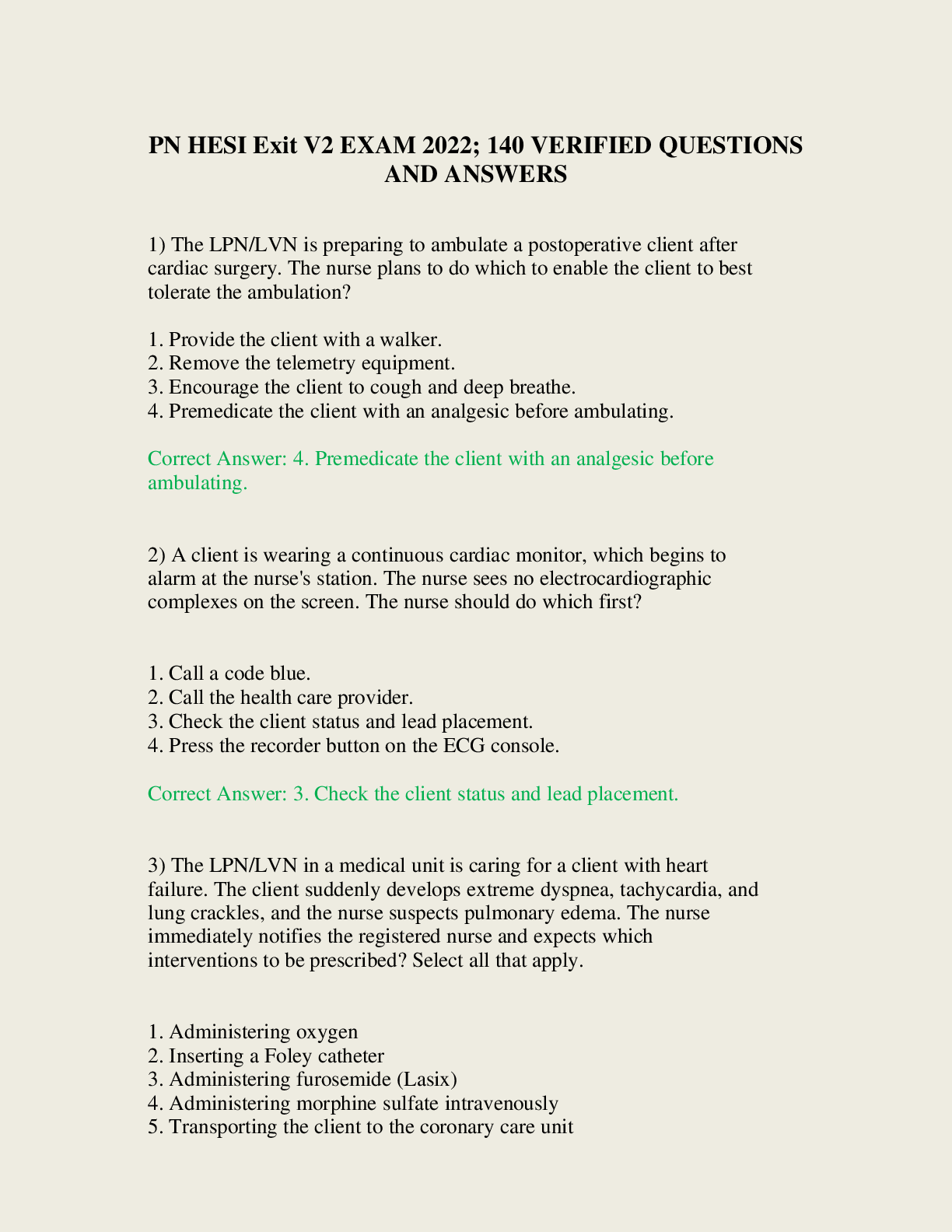
Reviews( 0 )
Document information
Connected school, study & course
About the document
Uploaded On
Jul 30, 2021
Number of pages
48
Written in
Additional information
This document has been written for:
Uploaded
Jul 30, 2021
Downloads
0
Views
96

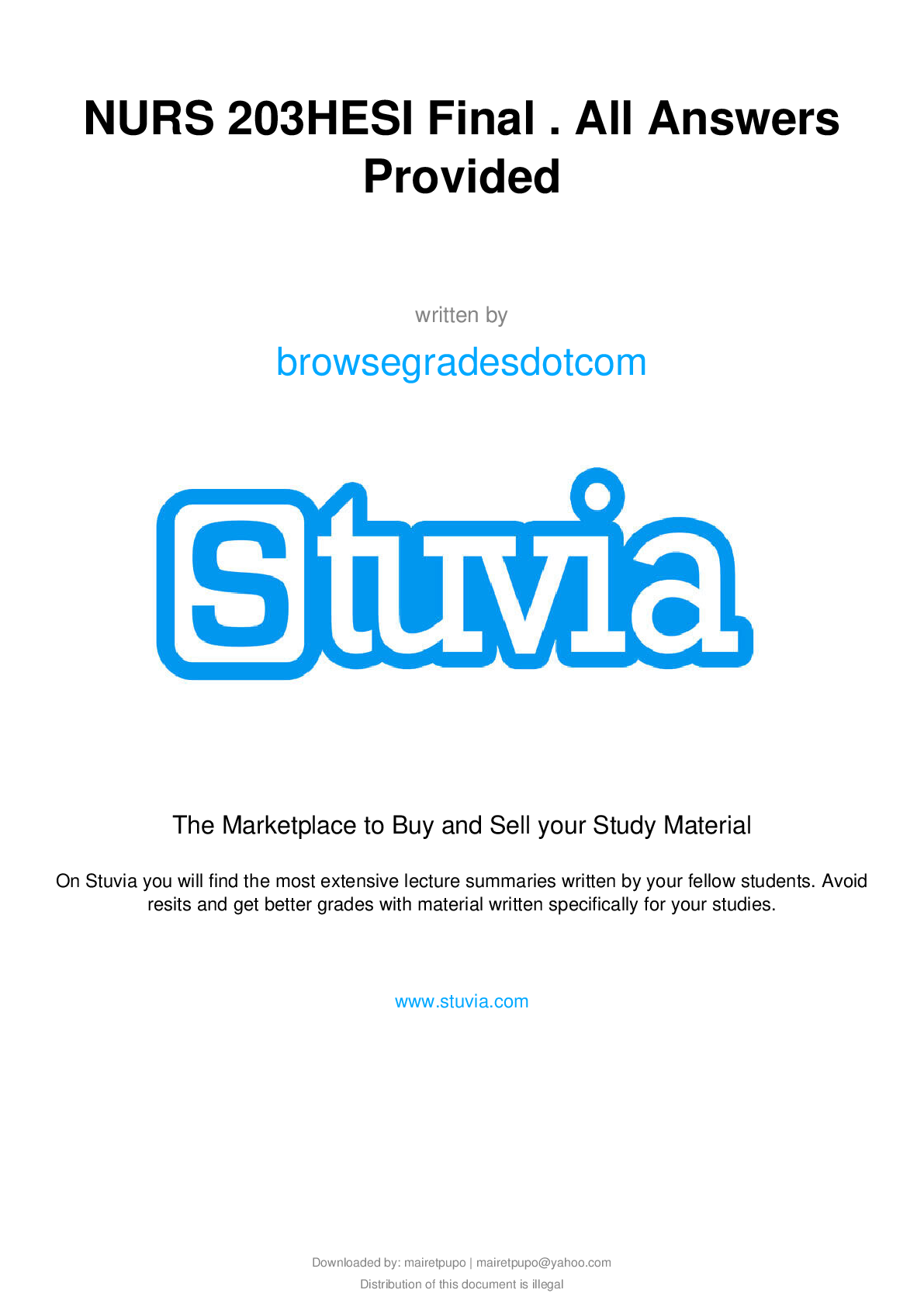
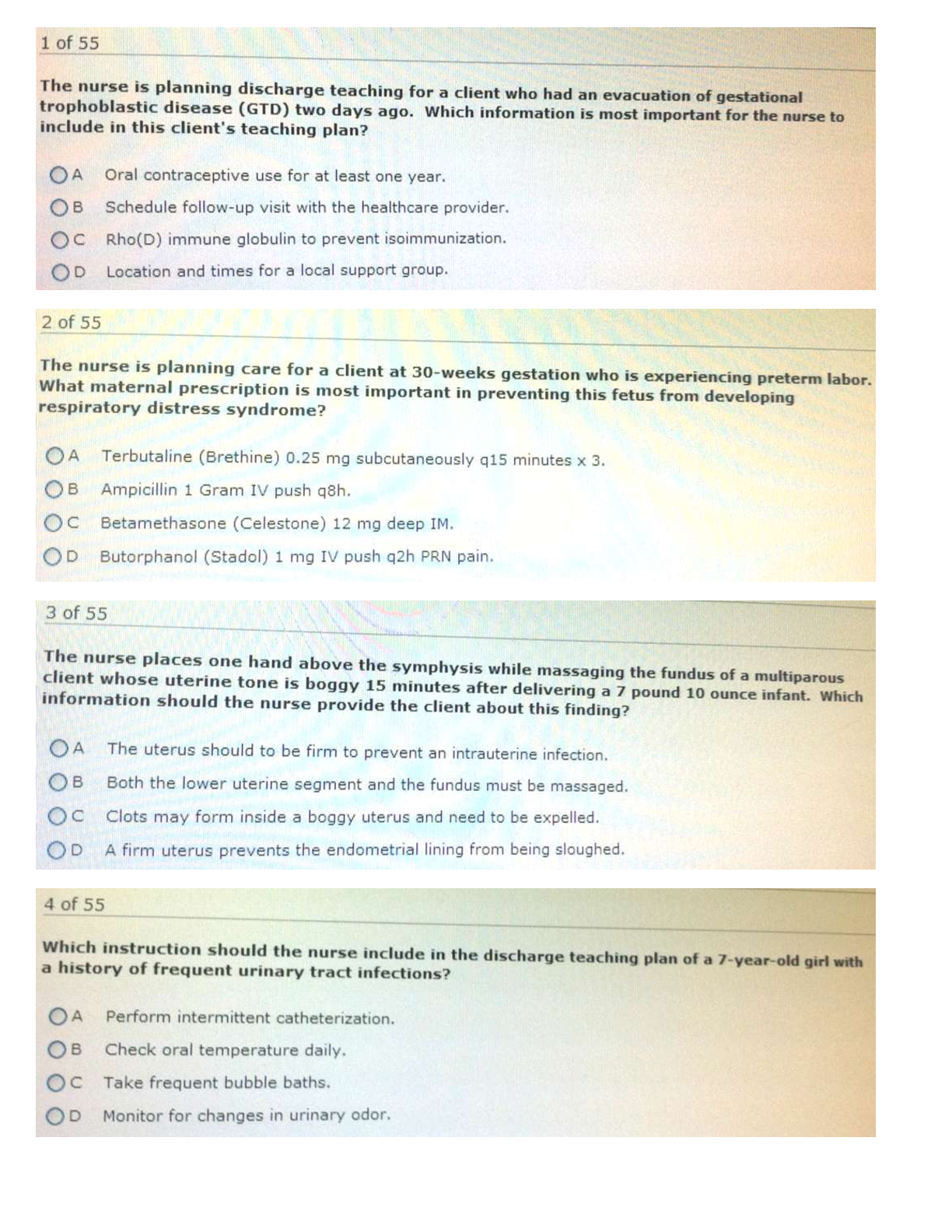
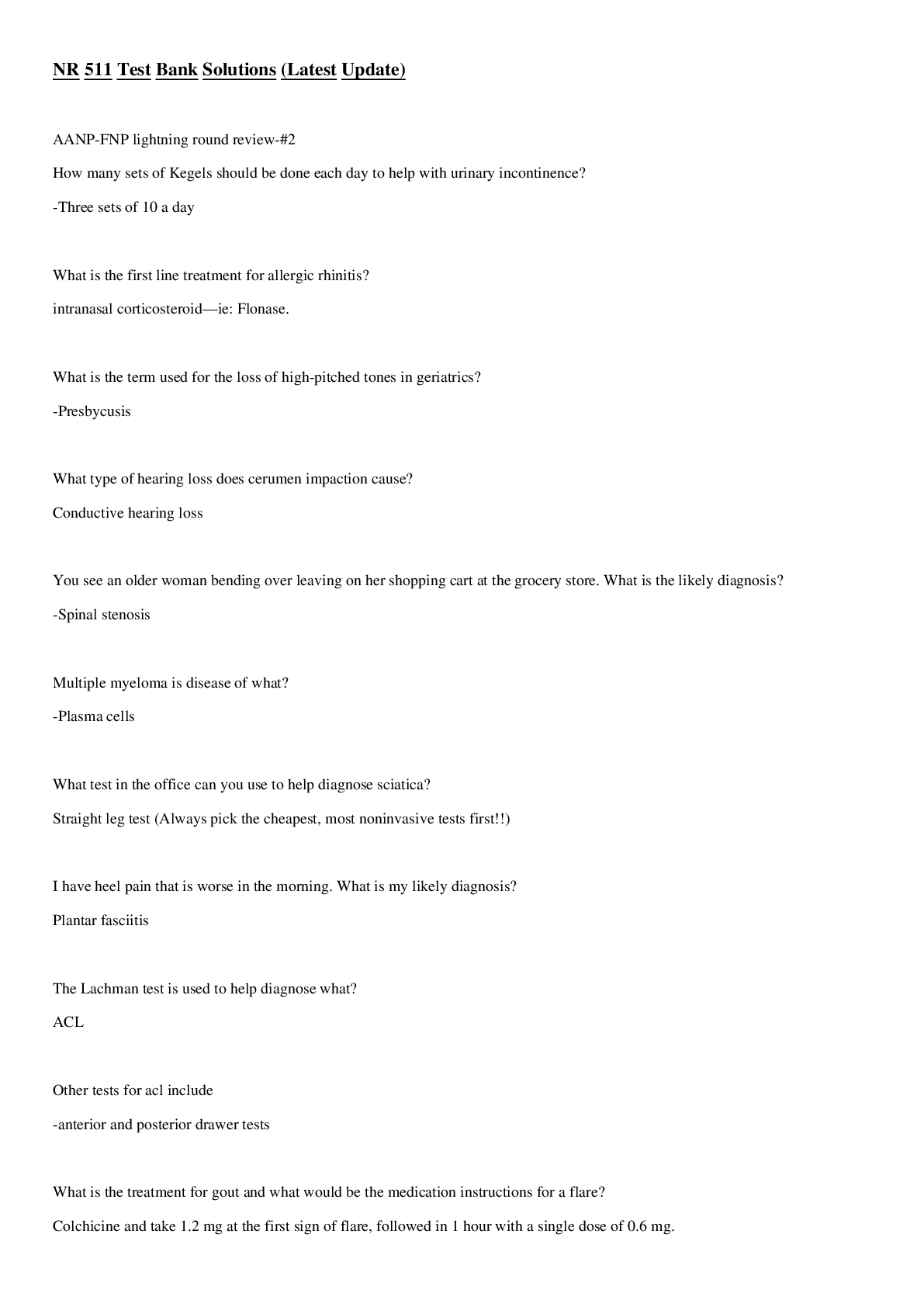
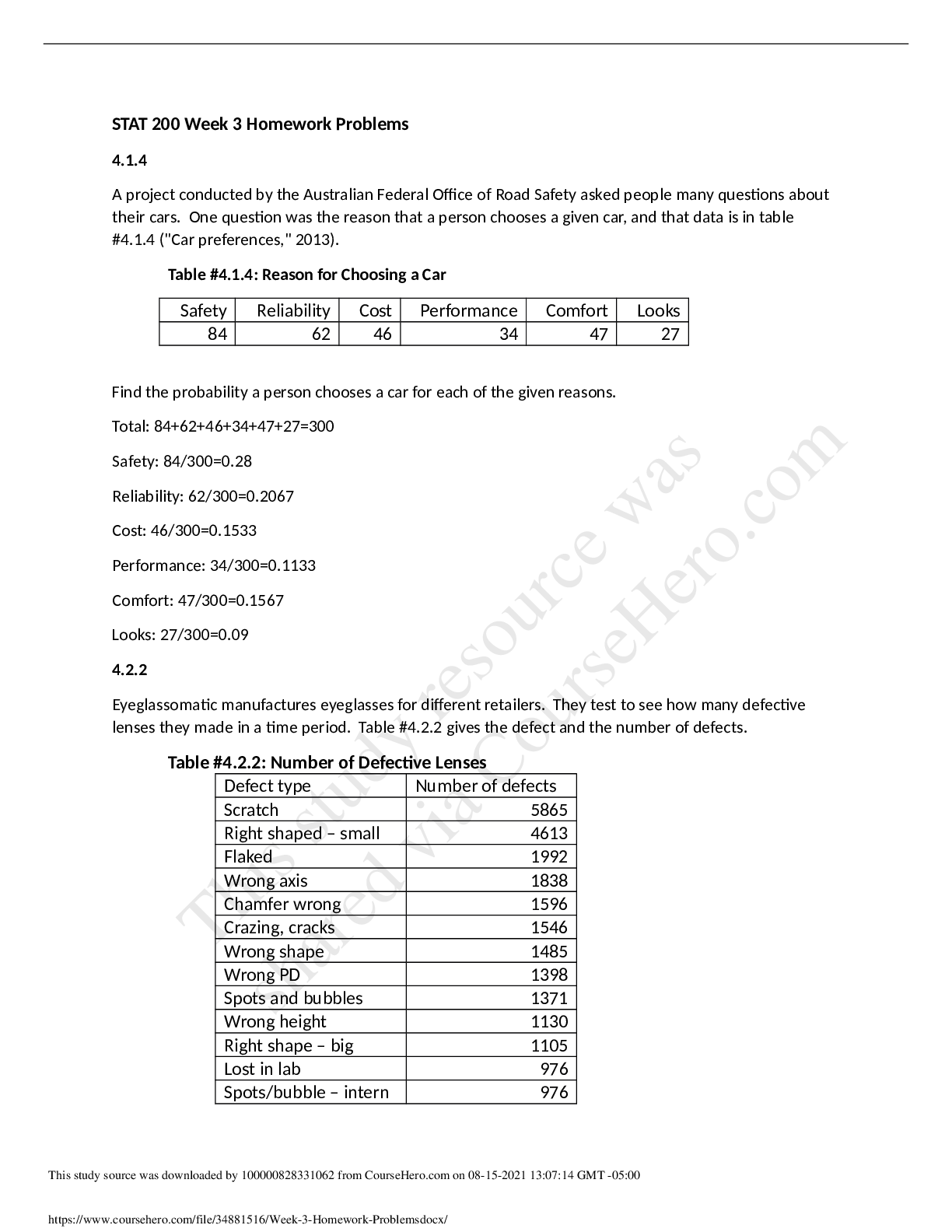
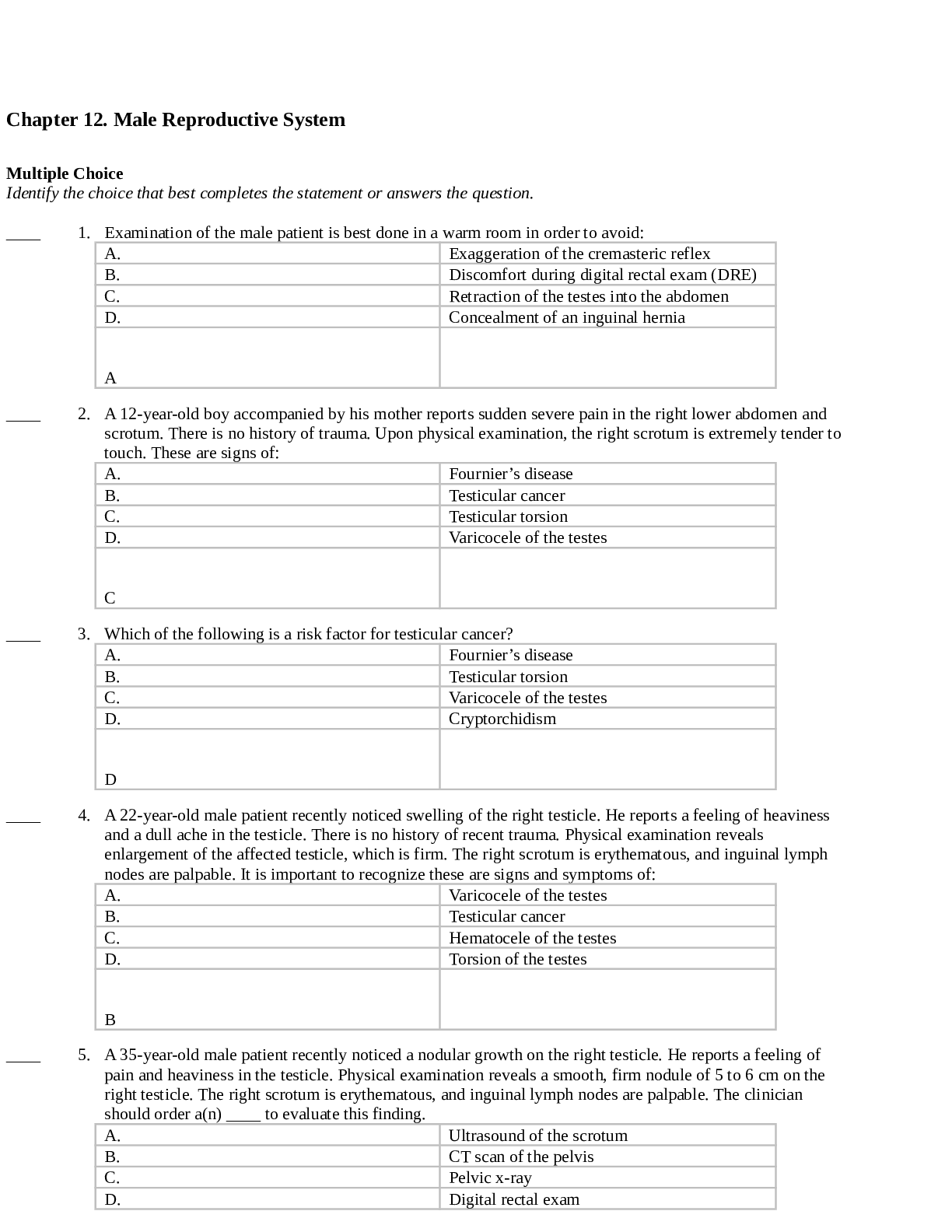
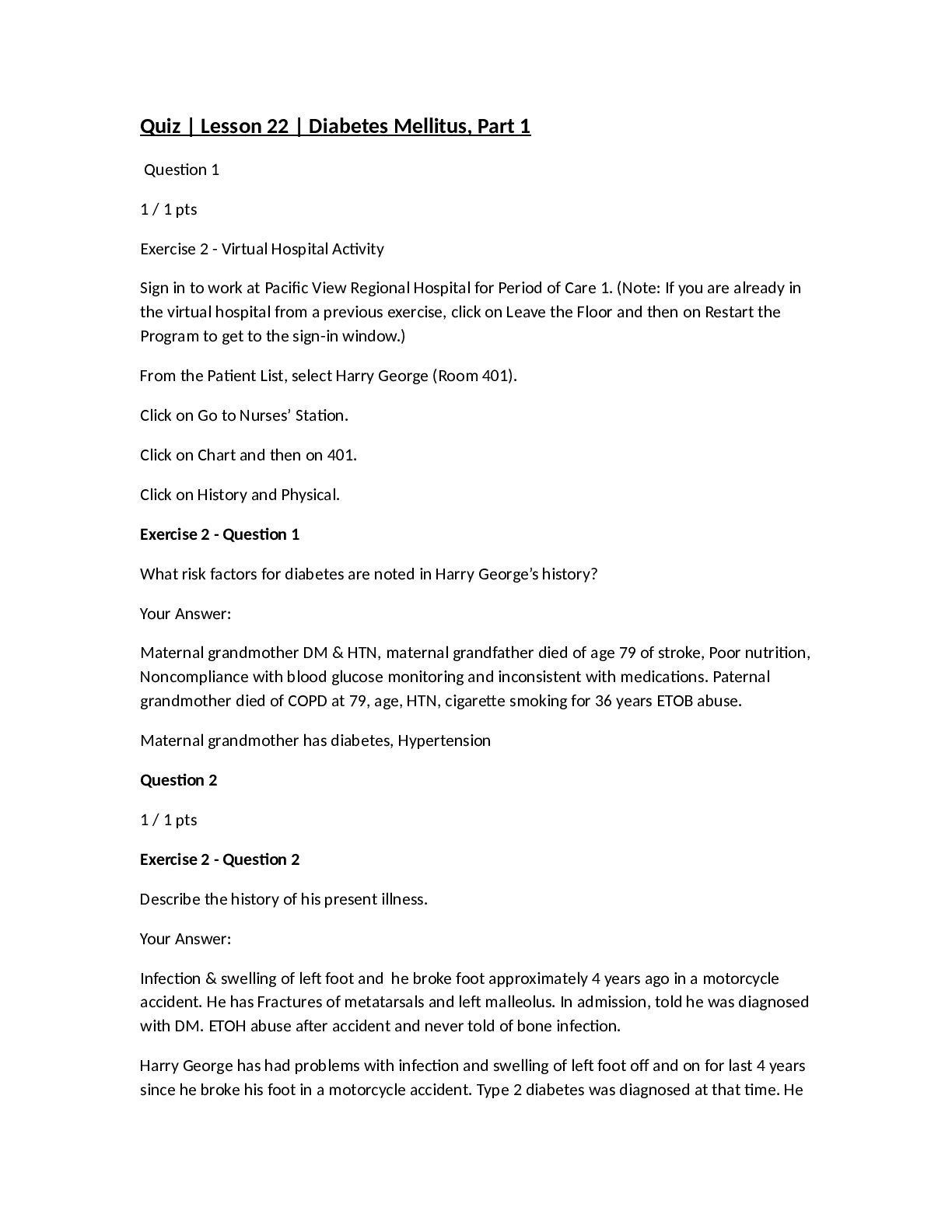
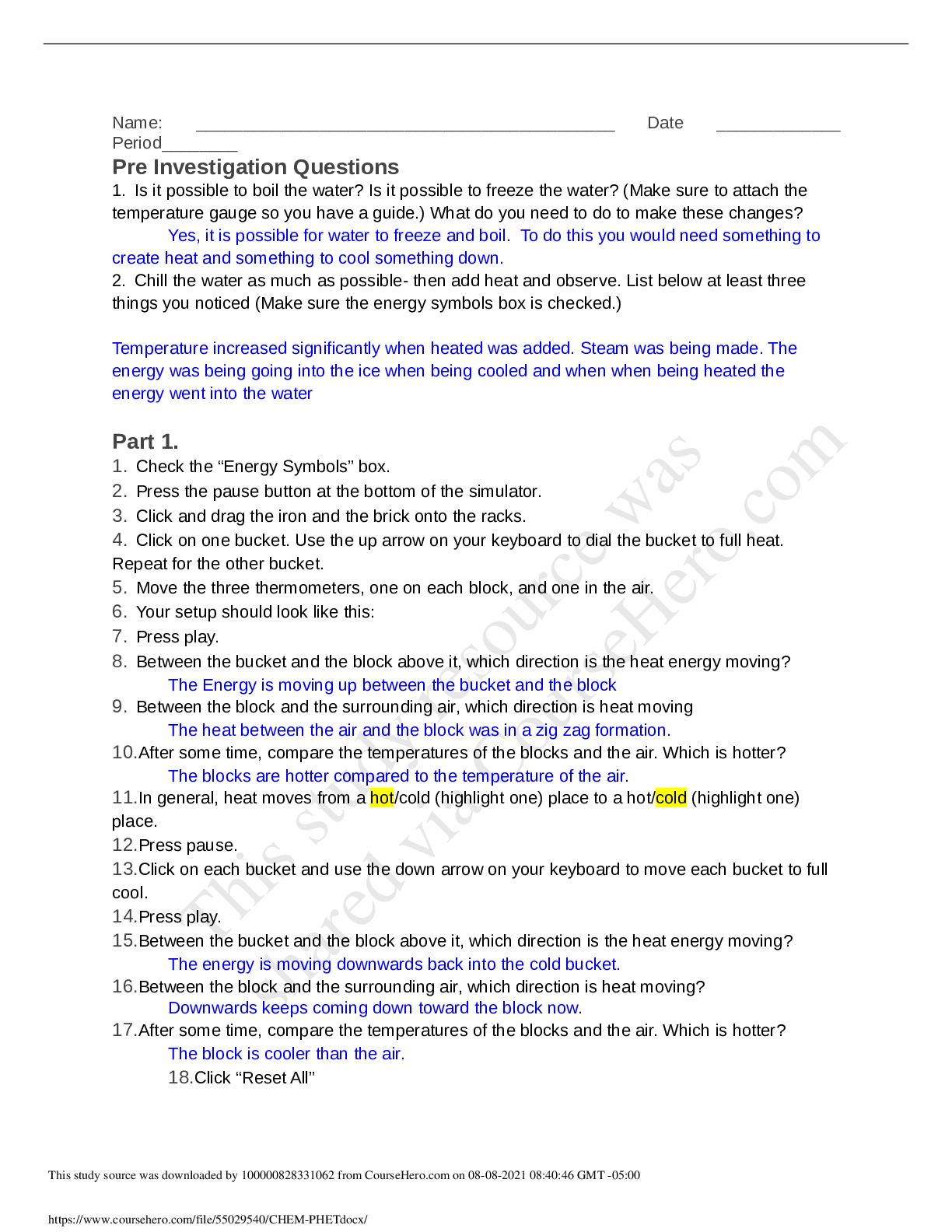
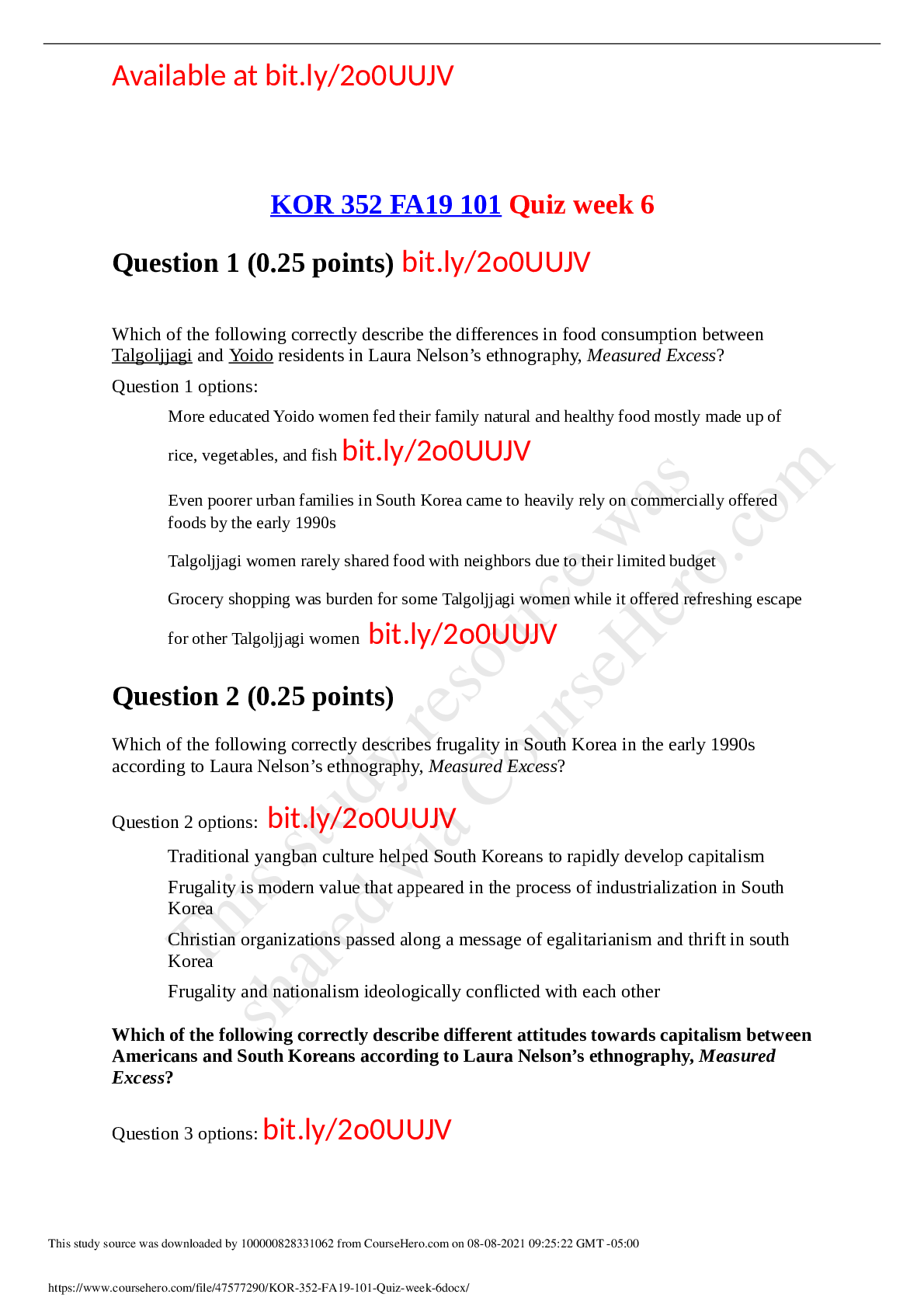
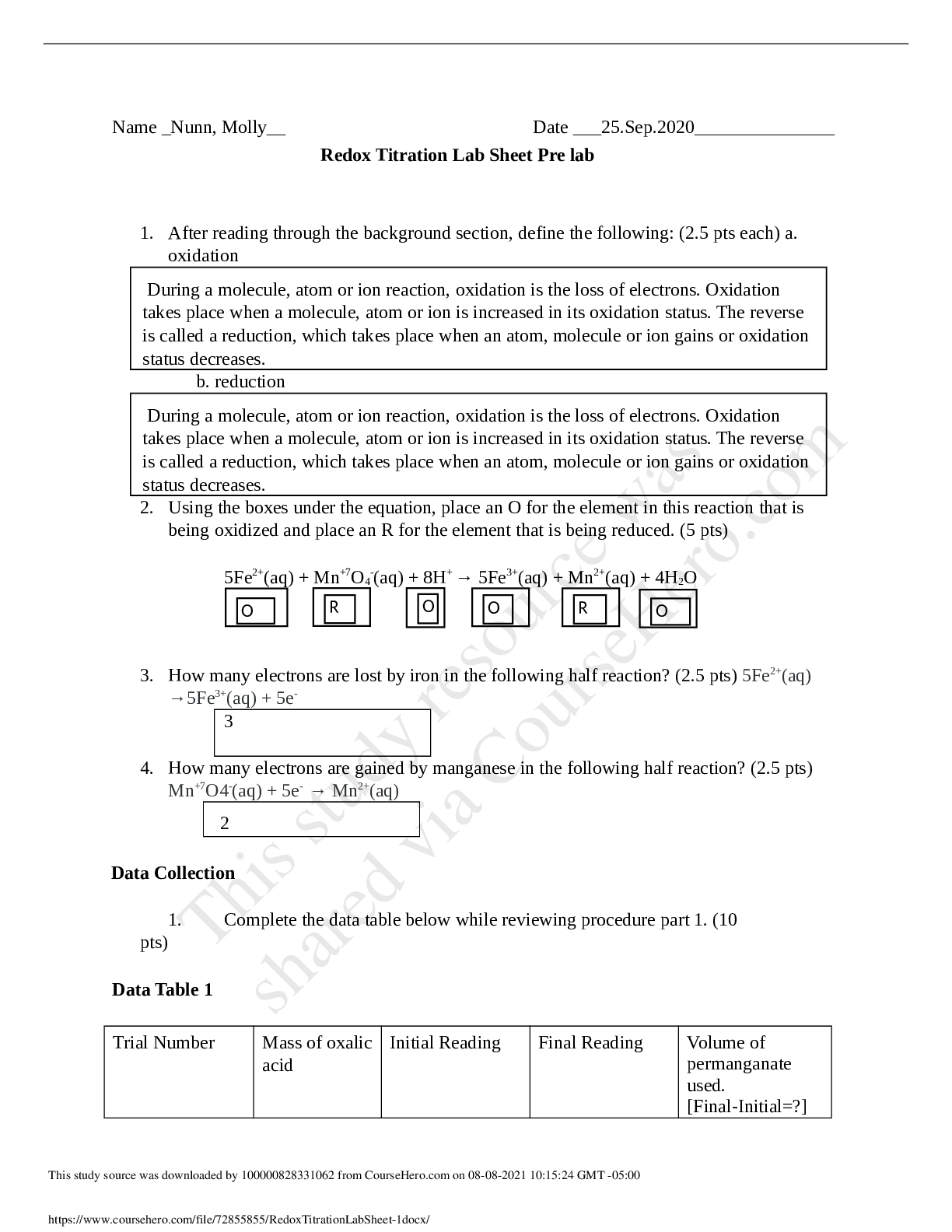
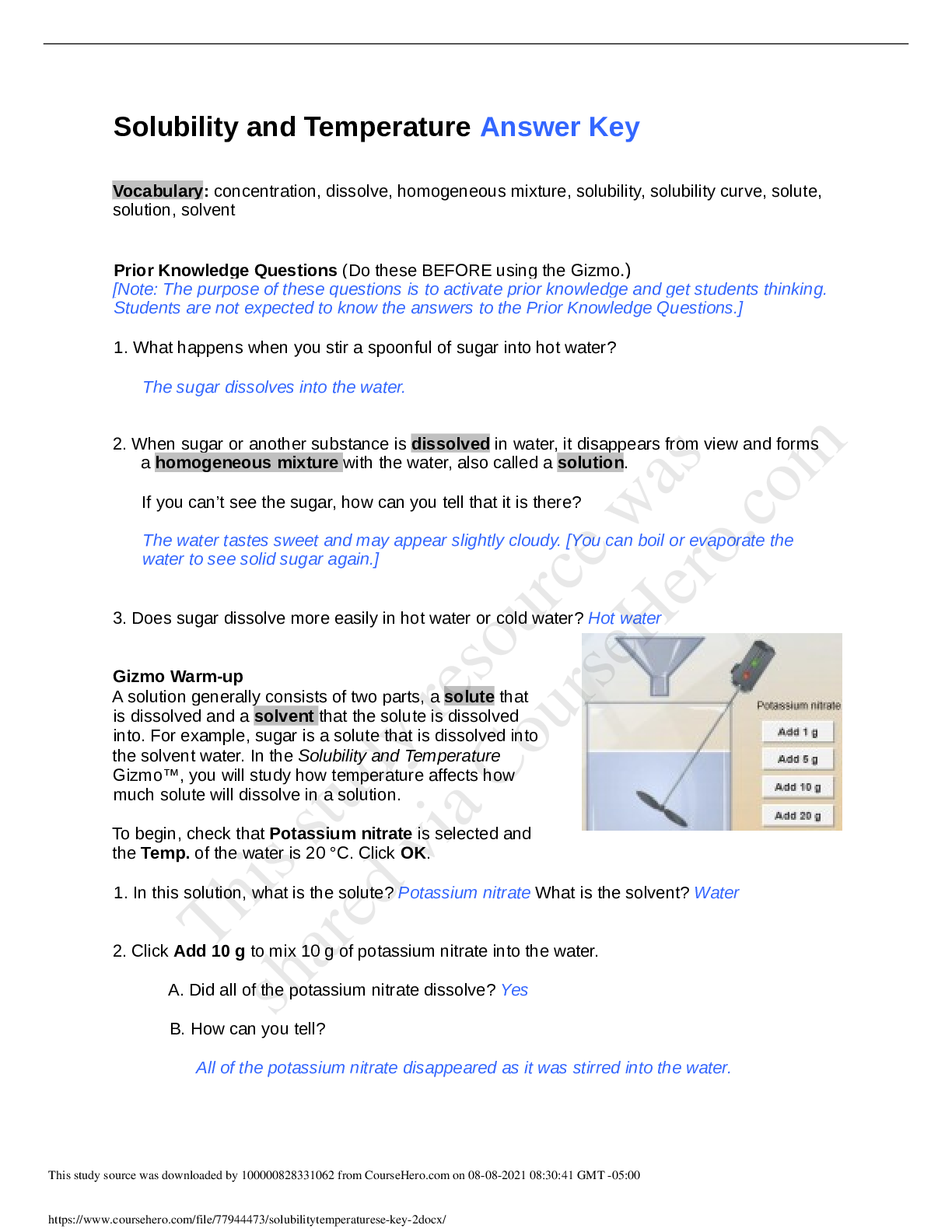
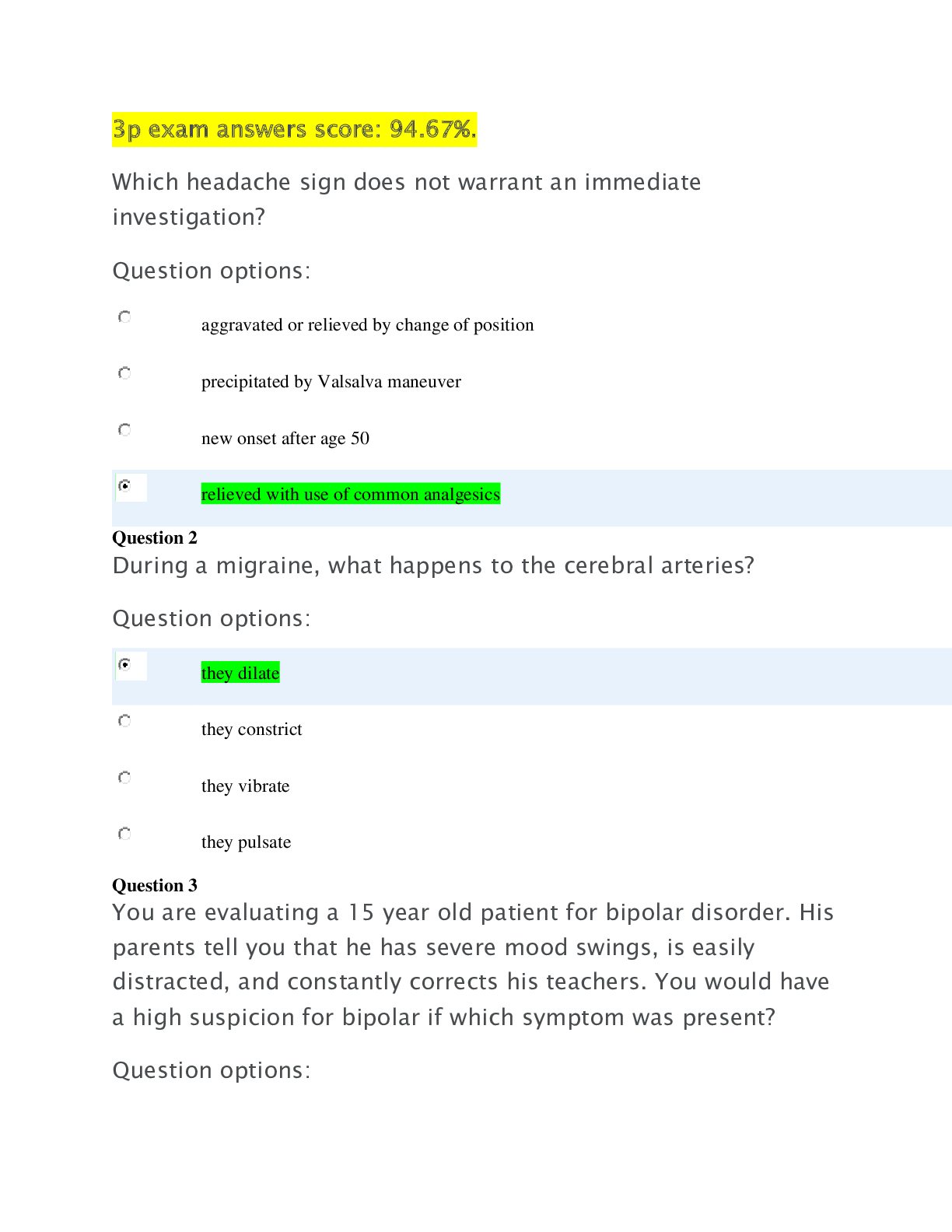

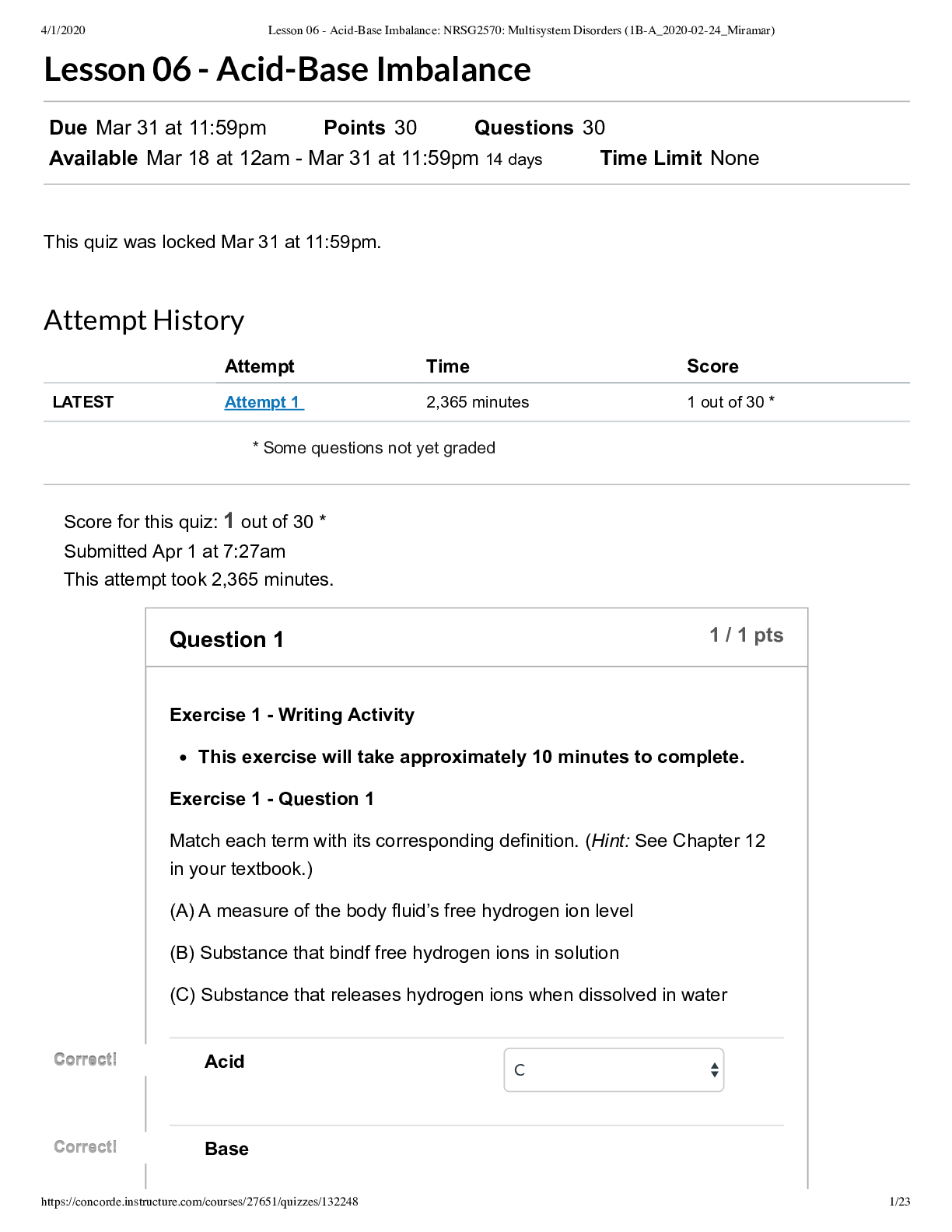
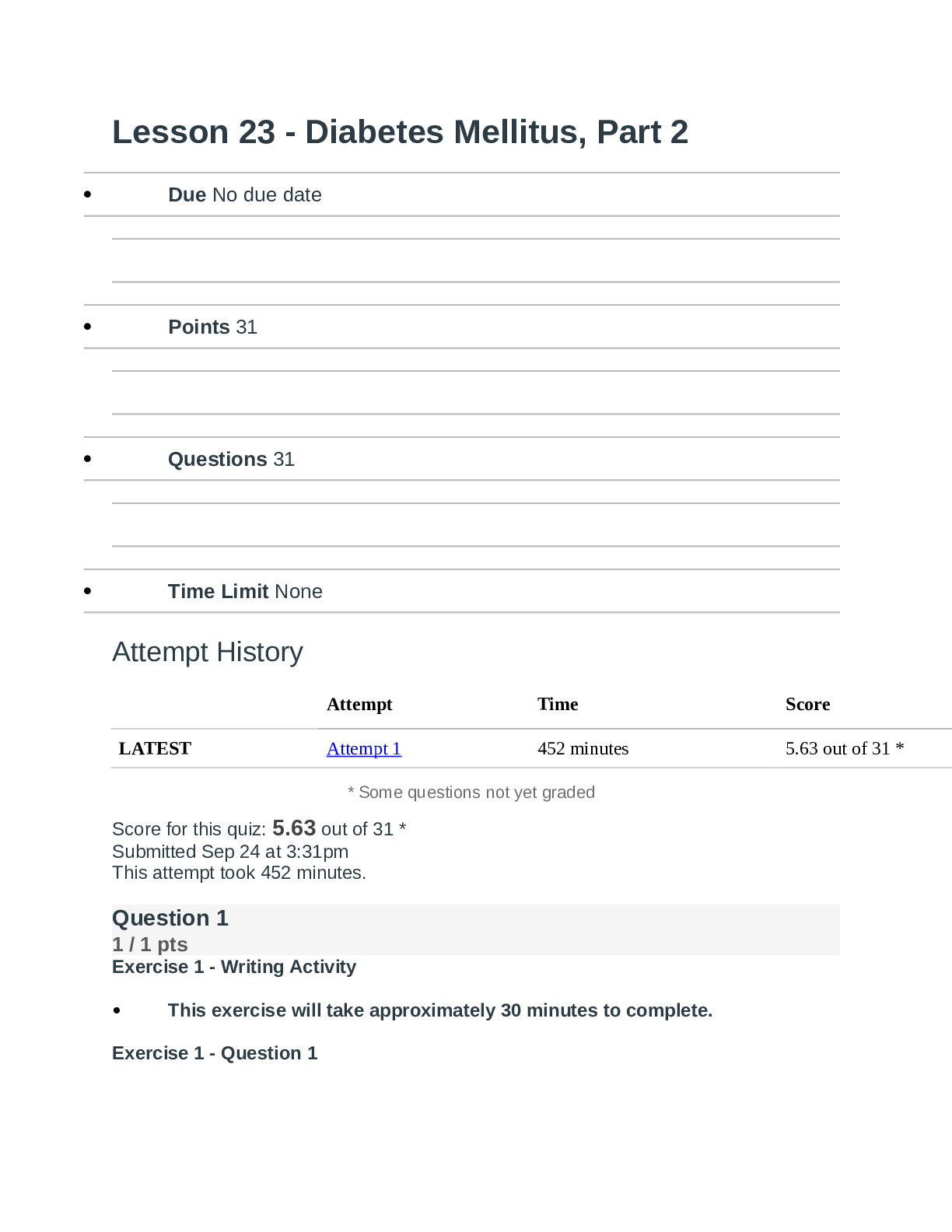

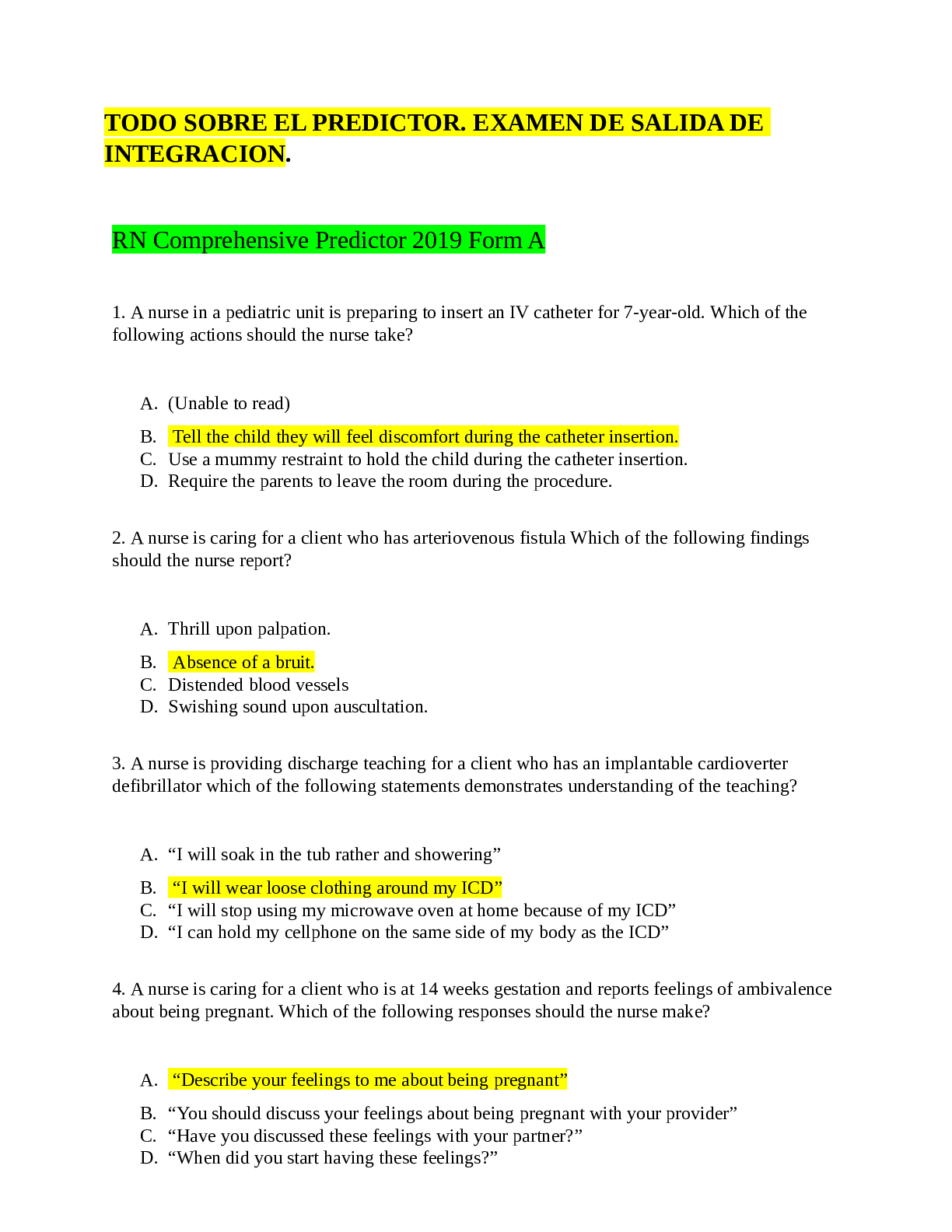
.png)
